#And they killed Dracula like 50 different ways to make sure he’s dead
Text
…
#My feelings on Renfield are weird because it’s a N/A truther movie but it’s representation of the codependent dynamic was weirdly on point#And the second m/c is a cop who’s sister is an FBI agent and the villains are drug dealing mob members and it’s critique’s of those systems#In 2023 are mild at best.#But it’s also a movie where a guy kicks another guy in the stomach and rips off his arms and then uses said arms as a weapon#And also a guy snorts a centipede like cocaine while saying the most corny line I’ve ever heard#And they build a protection circle from cocaine and said circle was made using instructions of Wiccan Tumblr#And they killed Dracula like 50 different ways to make sure he’s dead#And ngl I was very much expecting an end credit’s scene where the mob boss lady was Turned because it’s such an easy move#And it was just a fun splatterfest that I loved watching so-#I FORGOT THAT RENFIELD ATE A KIDS ANT FARM- just… Iconic scenea
5 notes
·
View notes
Text
Here we are lads, new post in my Dracula binge adventure. I'm on post number 3 and adaptation number fuck if I know. A lot.
So this one is Dracula 3000 (2004). Presumably different than Dracula 2000. Hopefully better, but we'll have to see.
This is set in the future, in space, which is a vibe. Right out of the gate I'm giving it not a lot on accuracy so we're going based purely on vibes, which are as we've gone on, the rating system that I have developed.
We've got Abraham van Helsing, captain. Arthur Holmwood, "The Professor" who is apparently not that smart, Mina Murray, the navigator, who is also apparently not good at her job. These are all the original characters. This is gonna be a wild ride.
Point for acknowledging that Arthur exists. I think they actually meant to make him Seward though.
I will say that it's interesting how they did the Demeter and are setting up the conflict, with the Demeter being an abandoned space ship and the main characters having to investigate it. The corpse is cool too how they tied it to the book. The hair is way way too long though.
I am obsessed with the effects and the filming of this, the angles and transitions are everything.
I'm getting real Among Us vibes from this. There sure as hell is an imposter here.
Obsessed with the fact that the ship is Space Communist. Also that Transylvania is an entire planet of vampires and that Dracula is the last one cause the planet is dead. Like no shit, a planet of fully vampires is not sustainable, there's no food source.
I admire the crew's dedication to guns, even after multiple demonstrations that it is completely ineffective.
How and why on earth did Vampire Mina get makeup where 1) they are in the middle of space on a 50 year old ship in the middle of deep space 2) why would her priority to be put on makeup and lie in a coffin instead of going to go eat the rest of the crew and 3) why didn't the dudes get a makeover.
I do appreciate how they made van Helsing descended from famous vampire hunters, and all bad ass I'm gonna kill these fuckers and then immediately get his ass handed to him by Dracula and turned into a vampire, and then immediately staked. He was giving Last Guy In A Horror Movie energy but nope, not today. Lol.
Point(?) for managing to to make every single character so profoundly and fundamentally unlikable in completely different ways. Like, everyone here sucks ass so hard, it's hilarious.
Also, in this scenario there's no downside for just. Letting Dracula suck your blood. Like, you don't Die die, you just turn into a vampire and become slightly more feral. Like, it's either turn into a vampire or be stuck on a ship being hunted, just cut your losses, man.
Ok no but that ending, I'm in love with it. Most of the crew was a vampire, then stabbed. Dracula got his arm cut off in a door. The only surviving guy left and the badass girlboss who was actually a government sent robot but before that was a pleasure bot leave to go fuck. There's a recording of the former captain of the Demeter from 50 years ago says he has to sacrifice himself and the ship. 50 years in the future I guess. The ship blows up. The end. Perfect. Classic. Beautiful ending. No complaints.
So overall, for accuracy it's like, in the negatives. None to speak of. However, in terms of vibes, despite all the characters being completely and utterly loathsome, I did like it. It wasn't supposed to be funny, but it sure as hell was. 7.5/10 it wasn't good, but it sure was a good time.
27 notes
·
View notes
Text
youtube
I don't always agree with Nerdrotic, he can tend to just hate things instantly but I have been monitoring how works in Hollywood are going lately and this pretty much tracks from following reports I've heard. This D.E.I mess is getting out of hand. It should be a choice to include diversity in your works, not an obligation, and you sure as heck shouldn't be hired just based solely on your skin color, gender and sexuality.
Yes it nice you wanna give others a fair shake, but extremely unwise to shun writers with plenty of experience with people who've yet to prove themselves. Theres a reason writers use a round-robin system for this. Plus like Tyrone said, this is feeling very smothering to boot. In fact, I told a friend of mine it reminded me of that old South Park ep with Nurse Gollum where the town tried to celebrate her, but got the point of being very uncomfortable with it since they keep focusing on the dead fetus on her head that she eventually told them off when she couldn't take it anymore. This feels very similar but on a larger scale. Wanting to be sympathetic but eventually going overboard. Goes without saying, but people want to be entertained, not lectured.
And these practices feel so...cartoony it 's hard to believe. I legit fell ill at the part of "not reading the source material to make something for modern audiences". Okay just ALL THE NO on that. I don't mind a different interpretation but you do your work a disservice by not at least getting a grasp on what the story or how a character should be portrayed, if nothing else to at least give you a general idea TO make it your own. Yes going blind can work sometime, but that's a very narrow 50/50 chance. Heck I want to do a version of Dracula down the line for a comic that'll be different from the source material. It'll make some changes, but it'll still respect what came before and use what was written to expand on certain things. The main reason being graphic novels have done the comic justice so that can afford a different interpretation. But otherwise the story will still be similar AND respectful to the source. And I will have the novel on hand to help that along the way.
From what I'm hearing these idiots act all proud became "Oh it was my version and not what came before". People would KILL for the chance to do a film or TV adaptation of certain works and these people are squandering it for fanfic versions of these stories without even knowing the full context when they could make timeless definitive versions. Hey fun fact, did you know the director of the second Star Trek movie didn't know a thing about the franchise going in? You know what he did, WATCHED THE SERIES OVER A WEEKEND TO GET AN IDEA FOR THE CHARACTERS! And what happened? One of the best Star Trek films in the franchise. So no that is nothing to be proud of, its just laziness.
And then there's this "Male and Pale is Stale" creed. I was taught to just make good characters in general regardless of gender. But this is what they're peddling to potential writers these days (at the time of this writing)? Why? No one was oppressing anyone up to this point concerning that, if anything it's healthy to have variety on both genders (hell even moreso with non-binaries) take the lead. But these social media nuts (particularly around Twitter) decided we need more of an influx of females and ethnicities all of a sudden? Also ignoring that many people are still white skin regardless of nationality making that ceed extra stupid. I don't get it, we had a good thing before that was balanced and focused with your own choice how the character should be, now it just this messy blob of forced templates that can't tell its left from its right and the stories and characters suffer because of it. It's just frustrating to view.
Again I'm not against diversity but I'm not foreign to it either, I grew up on plenty of shows that had it and did it in a much more tactful and graceful way that was by the creator design, not forced, and were still very entertaining. That era had plenty of fairness to it, so I don't know why that same curtesy can't be used for today. If it's to right some slight in the past, then sure but there's the saying "Two wrongs don't make a right". From where I'm seeing in this current age, the so called "oppressed" have become the the oppressors themselves and don't even realize it and media is suffering for it. And as a creative myself who would love to get his work to that mainstream someday, that's just disappointing to see.
0 notes
Note
I’d love to hear your thoughts on the Irish-ness of Dracula, if you wanna ramble about it!
(Okay I just want to apologise for how long this took to answer because I know it’s been sitting in my inbox for over a month but..depression and work happened and I just didn’t have the time or energy to complete it. I seriously do apologise for this but I hope you enjoy the post anyway!)
So the first thing I need to clear up is this: the concept of a monster or a demon that feeds upon the life force of humans is not limited to one singular culture or folklore. In fact, this core concept is a wider cultural phenomenon and variations of it exist across both countries and continents. And no one country can take sole credit for the this core concept of vampires. Anyone who tries to claim otherwise either doesn’t know much about vampires or is intentionally being disingenuous. There can be cultural variations that are specific to certain folklores (and to just blatantly steal these would be cultural appropriation), but the main idea of vampires exists across a wide range of folklores and no singular person, group of people or culture can take credit for the creation of vampires.
However, arguably it was the work of Bram Stoker that aided in the solidification of the concept of Vampires that we know today. While there were other authors from a wide range of nationalities who wrote about Vampires before Stoker (including John William Polidori who wrote the Vampyre in 1819)...Dracula is the best known. (Now I personally believe that’s because Dracula is an absolutely banging novel, although I do concede that the prevalence of adaptations of Dracula from the 1920’s to today helps keep Dracula in the forefront of audiences minds.) In addition, it’s important to remember that Stoker was inspired by another Irish author Joseph Sheridan Le Fanu, who wrote the novel Carmilla. As far as I know, Le Fanu and Stoker actually worked together on a magazine!
Another thing I think that needs clarification is the common belief that Stoker heavily/religiously based Dracula on the historical figure Vlad the Impailer. This is heavily debated by scholars. While there’s an obvious, undeniable similarity between the names of these two...the similarities start to wain after this, with only small similarities between the two and there’s even literal contradictions between the history of Vlad the Impailer and Dracula’s history in the novel. In fact, there’s not much indication that Stoker based the character Dracula off Vlad the Impailer, or even that he had a working knowledge of Vlad the Impailer beyond the name. In all 124 pages of his notes, there’s nothing to indicate that Stoker’s inspiration for Dracula came from Vlad the Impailer.
(Plus Dracula in the novel wasn’t even originally called Dracula...he was called Count Wampyr in the original drafts of the novel and this was only changed, from what I can gather, in the last couple of drafts.)
In fact, I’d personally argue that that connection between Vlad the Impailer and Dracula is actually something that’s been retroactively added by other artists, for example the 1992 film “Bram Stoker’s Dracula” heavily leaned into this idea that Dracula and Vald the Impailer were one in the same, and as time has progressed people assume that these elements were in the original novel when that’s simply untrue! Stoker didn’t write that! It’s a retroactive addition by other artists that’s just assumed by the masses to be canon. This phenomenon is actually super interesting and it’s absolutely not limited to Stoker’s novel Dracula/the modern day perception of Dracula (another example would be Mary Shelley’s version of Frankenstein versus the modern day perception Frankenstein). I’m not sure if there’s a word for what this is, but I like the term “cultural canon”, where something that’s been added in by other artists has become as good as canon within the minds of the masses and as such is ingrained within the cultural perception of something, despite it having no basis within the original piece or even directly contradicting what is in canon.
(Now I’ll absolutely concede that Stoker taking the name of a historical figure and possibly their likeness from another country and making them into a literal monster is something that should be discussed. I don’t know how Vlad the Impailer is viewed within Romania - whether he’s viewed positively or negatively or a mixture - but regardless he was a historical figure and Stoker did eventually use that name for his own creative purposes. Again, Stoker didn’t say that Dracula and Vlad the Impailer were the same person, that’s other artists doing, but there’s still issues with Stoker that needs to be discussed)
Now, I’ve seen people talk about how Stoker took a lot of inspiration from the Baltic folklore surrounding vampires for his novel, but I don’t really know this folklore very well and therefore I don’t feel like I’m qualified to discuss it. If anyone is more well versed in this topic wants to add to this post then they’re more than welcome to! I don’t deny that Stoker too inspiration from places other than Ireland (like the novel is set in Whitby) but I just feel like people over hype the relation between stokers Dracula and Vlad the Impailer.
Now, onto the Irish mythology side!
So the most obvious inspiration for Dracula comes from the story of Abhartach. here is a link to an actual, respectable retelling of the story of Abhartach which I’d highly recommend people read (it’s really not that long) but the key points go as follows:
There was this Irish chieftain called Abhartach, who was really cruel and the townsfolk didn’t really like him. So, the townsfolk and another cheiftain (known as Cathain) banded together to kill Abhartach. They did succeed in killing him (yay), however, Abhartach just sort of...rose from the dead and began another reign of terror (not yay). However, Abhartach needed to be sustained by blood and required a bowlful every day to sustain his energy. Cathain comes back and kills Abhartach once again, but Abhartach rises from the dead once more and now needs more blood. Abhartach is only banished when Cathain uses a word made from yew wood and wounds Abhartach with it. Abhartach is buried upside down with a grant stone over the grave to stop Abhartach rising once again.
Sound familiar? The similarities between Abhartach and Dracula are undeniable! Yes, there’s some differences between the two but the core story here is almost identical. I could totally reword that paragraph, omitting the names, and it would be indistinguishable from a short summary of Dracula! Even the way that the main characters find out about the wooden weapon that can kill the monster is similar, as both Jonathan and Cathain go to wiser and older members of their community to learn more.
(Also please mythology blogs don’t come for me I know my retelling was an incredible oversimplification but I’m writing on my iPad and my thumbs are starting to hurt. People have wrote full papers on the similarities between Dracula and Abhartach and there’s so many more people more qualified than me, I’m just an 18 year old trying to make a fun and interesting tumblr post. Again, if anyone wants add anything like extra sources or more information or even to point out my mistakes then I more than welcome the additions)
Another piece of folklore that’s also said to have inspired Dracula is the Dearg Due. Now there’s multiple different versions of the tale, but the version I have heard goes like this:
There’s a noble woman who wants to marry a penniless peasant boy, but her dad disapproves and wants her to marry another man who is much richer. The rich man and the noble woman were eventually married but the woman didn’t love the rich man. In retaliation, the rich man locked the woman in a windowless castle where she starved to death. The woman was buried by the locals who took pity on her, but because she was buried hungry she came back to life and drank the blood of her father and her husband as revenge. The version I heard says that the dearg due now basically wanders ireland drinking the blood of men who have hurt or wronged women (as one should) but there’s other endings to the story.
(Again is anyone has a reliable source they want to share then please feel free to add!)
So this is another Irish piece of folklore that clearly includes some elements that we now associate with vampires. Now people (including Wikipedia) claim that this story was specifically what Stoker based Dracula on, and while I definitely think that Stoker was aware of this story and took inspiration from it, I personally think that the Dearg Due inspired the concept of Dracula’s wives more than Dracula himself.
However the key point still stands: Stoker was likely aware of these legends and even the most staunchly anti-Irish person would have to concede that there’s similarities between all three stories. And very rarely are these similarities discussed in classes about Dracula...which I feel is a real disservice. I don’t think students should have to have an intense knowledge of Irish mythology (my knowledge is spotty at best) nor do I think it should be an exam question...but even a brief acknowledgment of “hey, Stoker was inspired by these stories and you can clearly see similarities between them” would be nice. Moreover, it further solidifies my original argument that Stoker was, at least to some extent, Irish and that his Irishness inherently influenced his work.
Also...the social context of what was going on in Ireland in this period can’t be ignored! Again, while Stoker did spend time in both England and Romania, he spent a lot of his life in Ireland and therefore would have known what was going on in his own country.
Dracula was published in 1897, which is exactly 50 years after the worst year of the Irish Famine/ The Great Hunger/An Gorta Mór. Now I don’t have time to do a whole history of the Great Hunger but the effects of the famine were greatly exacerbated by the horrific mismanagement of Ireland by the British government and the British system of ruling in Ireland. How many people died during the famine isn’t clear, but we do know that the population of Ireland at the time was 8 million and the population today is 6 million...200 years later and we still haven’t recovered. So while we all like to joke about the fact that Stoker wrote about an unfeeling member of the aristocracy literally feeding off others with no remorse and basically ruining their lives...are we really going to pretend that there isn’t social commentary there? Scholars specifically think that Stoker was commenting on the absentee landlords (basically British aristocrats who owned land in Ireland but didn’t live there and as such didn’t care about the well being of their tenants) who would often have tenants forced off the land when they couldn’t pay rent...despite the fact that their tenenants were already starving and had no money because their only source of food and income failed.
(I’m not being shady by the way, I also love to joke about the social implications of Dracula, but I feel like people forget that the jokes have actual points behind them)
There was also a cholera epidemic in Ireland in 1832 which is generally accepted to be one of Stoker’s biggest inspirations. You can read more about the epidemic here if you wish, but I’ll summarise what I feel are the key points. Not only was Stoker’s mother from county Sligo and lived through this cholera epidemic, but Stoker also asked her to write down her memories of the epidemic and used her accounts to aid in his research of the cholera epidemic. Now the fact that he was actively researching this should indicate that it would influence his work, especially considering the situation in county Sligo was incredibly morbid. There’s accounts of the 20 carpenters in Sligo town being unable to make enough coffins to keep up with the amount of people dying, resulting in hundreds of dead bodies just lying on the street. However, the most horrific account from this epidemic was the stories of terrified nurses placing cholera patients into mass graves while they were still alive. Stoker himself literally stated that Dracula was “inspired by the idea of someone being buried before they were fully dead”. So while at first there seems to be very little relation between the novel and a medical epidemic, it quickly becomes clear that Stoker’s fascination with this historical event influenced his writing.
My overall point is that Stoker’s irishness inherently influenced his writing. Writers don’t write in their own little bubble, divorced from the world around them, their views and work are shaped by their position in society and their upbringing (it’s why I dislike death of the author as a literary theory). So when people try to claim that Dracula is a piece of British literature...it indicates either a lack of understanding of the context in which Stoker was writing in or a wilful ignorance founded on colonialist ideas. His influences are so obvious to me as an Irish woman but they rarely get discussed, and even if they are it’s seen as overreaching! To call Dracula British literature and to ignore the inherent Irishness of the novel does a great disservice to Stoker!
Anyways I really hope you enjoyed this discussion my love! Once again I apologise for how long this took to write. Also I’m sorry if this comes off as argumentative or anything, that absolutely wasn’t my intention, I just have a particular style of writing long posts haha.
#dracula#bram stoker#irish literature#british literature#bram stoker’s dracula#gothic#gothic literature#ask#ask answered#anon ask#anonymous ask#anon#anonymous#being irish is my only personality trait
145 notes
·
View notes
Text
Hellsing Ch. 70-76
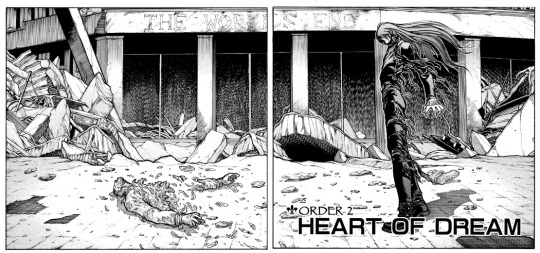
I guess anything I say here is a spoiler, so yeah, this is “Heart of Dreams”, “Relics”, “Heart of Iron”, and the arc “Finest Hour”. Oh, and “Lunatic Dawn”. Gotta lotta ground to cover. Treacherous ground.
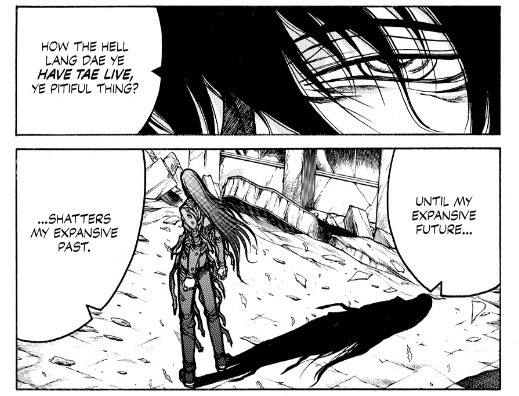
Not a whole lot to say about Anderson’s death. He tried to become a monster using one of the Holy Nails from the True Cross, and then Alucard defeated him anyway, once Seras gave him a little help and a reason to go on living. Alucard was pretty upset about Anderson’s demise, but Anderson says a few soothing words, and reminds him that Al only became a vampire because he couldn’t stand being a human, so it doesn’t make a lot of sense for him to cry now.
So yeah, as determined as Anderson was to kill Alucard, he’s a pretty good sport about losing this fight, and he seems to genuinely pity the man. He wonders how long Alucard will go on living with his regrets, and Al replies “Until my expansive future shatters my expansive past.” So, if we want to take that literally, I guess he’s trying to find redemption by being a good guy to make up for his years as a bad guy. Well, he’s been a vampire for 523 years, and a servant of Hellsing for 101 of those years, so I guess maybe he figures if he trucks along for another 321 years that’d balance the scales?
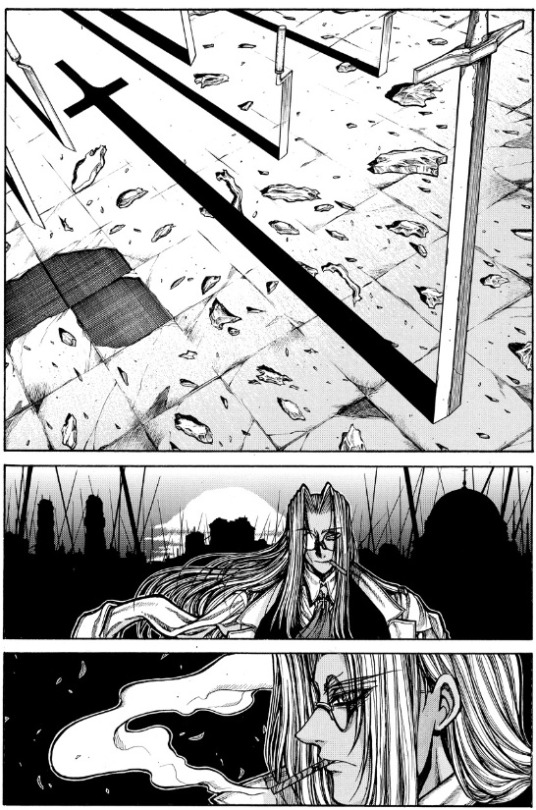
And maybe I’m finally starting to appreciate some of the complexities of Alucard’s character. The Team Four Star Abridged series spent some time on his desire for redemption, but I couldn’t tell if it was based on the original material or something they came up with for their own version. For instance, the Abridged!Alucard rejected the forgiveness offered by God himself, but later Anderson spoke of his desire for redemption and Alucard didn’t dispute that. It seemed contradictory to me at the time, but the manga does seem to support that. As Vlad Tepes, he refused to ask God for anything, preferring instead to fight and drive himself and his followers to the limits of endurance and decency as proof of their faith.
I find that idea heretical, because it suggests that a person can “earn” God’s favor, or God’s forgiveness, or a place in heaven. Arguably, Anderson tried to do the same thing, but I think he was coming more from a place of doing zealous deeds out of gratitude for the Lord’s grace, rather than trying to earn anything he didn’t already have.
The difference with Alucard is that he seemed to be really wrongheaded about his faith, trying to use violence to become a good person. Then it didn’t work, and he became a vampire, devoted entirely to his own selfish desires, and I guess he’s spent the 20th Century realizing that he’s back where he started, trying to fight his way to redemption, only now he has centuries of red in his ledger instead of mere decades.
Oh, anyway, while this is going on, Integra takes a sword and stands it upright so it looks like a cross to mark Anderson’s death. It’s like this quiet sign of respect. I’m not sure whose sword that is, but it looks like the one Alucard was using in his Dracula persona.
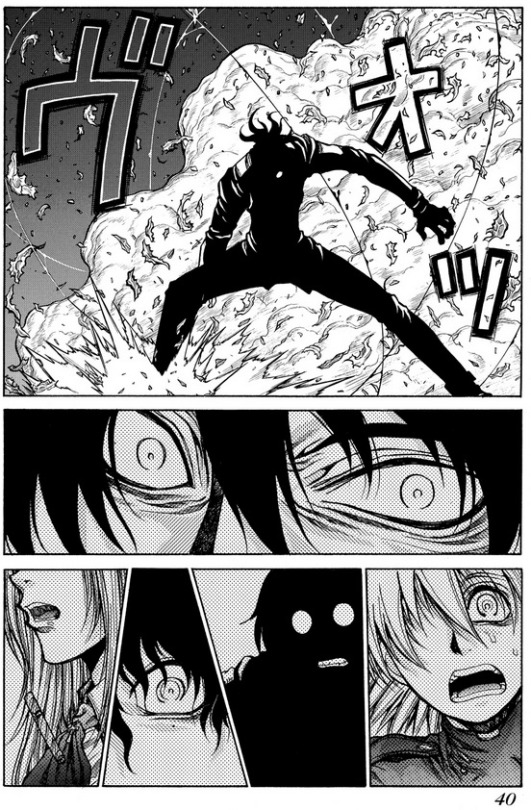
Anyway, fuck all that, because Walter finally shows up and stomps the ashes of Anderson just as everyone was having their final farewell with the guy. Rude.

Young Walter just looks kind of stupid to me. Why is he still wearing the monocle? He’s trying to be 14 and 69 at the same time and failing at both.
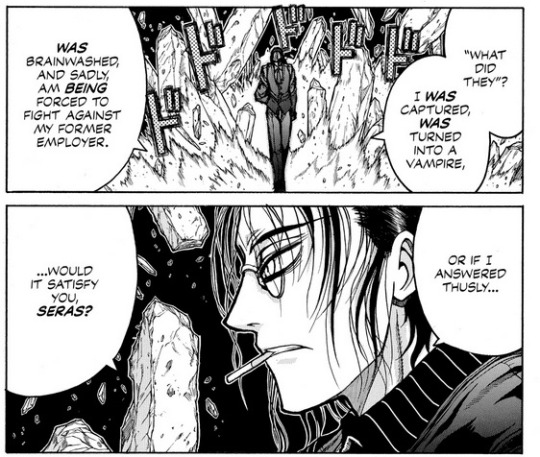
Seras asks what Millennium did to him, but Walter makes it clear that this isn’t some brainwashing trope. He’s doing this of his own free will.
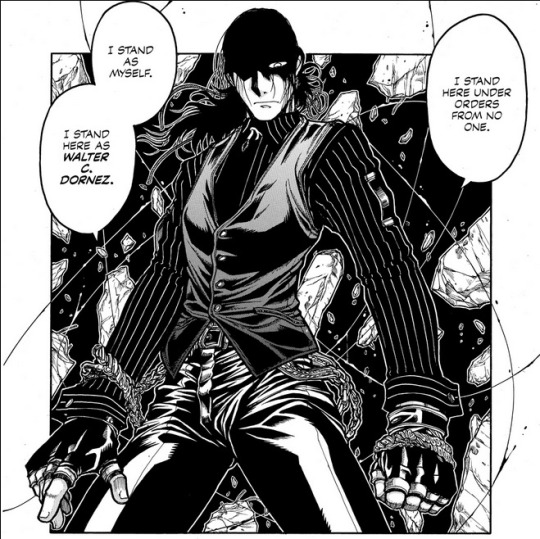
He also doesn’t consider himself loyal to Millennium. They turned him into a vampire, but he’s doing this for himself, and he’s only cooperating with them because their goals are in alignment.
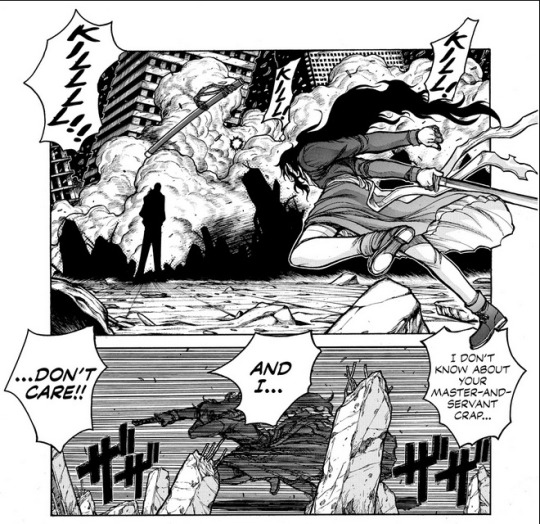
Yumiko Takagi tries to kill Walter for... Was she mad at him for stomping on Anderson’s remains? I mean, Alucard’s the one who actually killed Anderson, so shouldn’t she be mad at that guy?
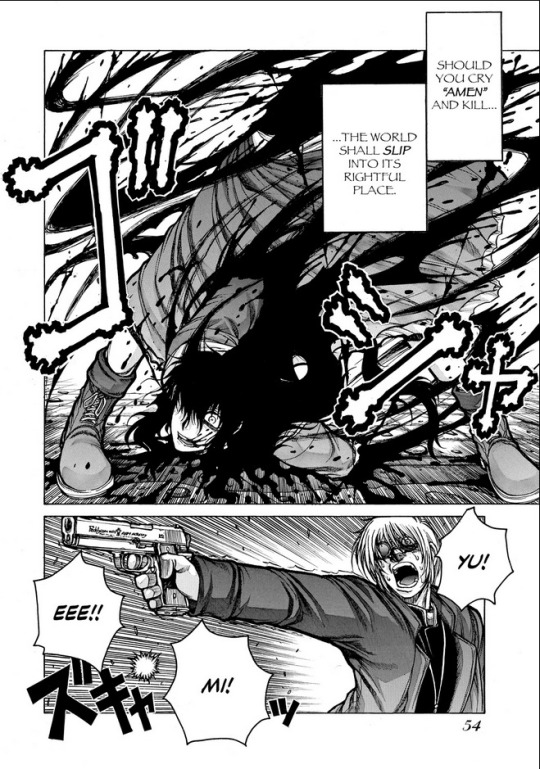
It doesn’t matter, because Walt just slices her into pieces with his magic filaments. Now Heinkel Wolfe wants revenge, because she was her long-time partner in assassin stuff. The TFS Abridged series implied that they were lovers, too, which seemed authentic at the time, but I’m not sure there’s any confirmation to be found in the manga itself.
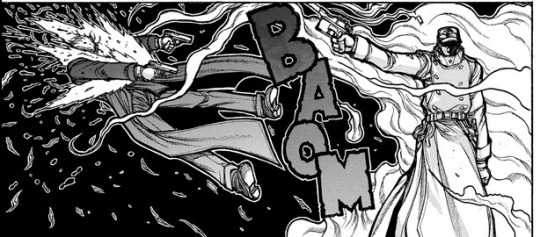
But before she can take the shot, the Captain shows up and shoots Heinkel in the face. Like, through one cheek and out the other, and the only thing saving her from serious injury was that she happened to have her mouth open at the time.
Side note: I caught myself referring to Heinkel as “him”, which frustrates me because I’ve known she was a woman for like five years now. When I first watched the OVA, I was confused, becuase I could tell it was a female voice actor, but maybe that just meant he was really young, like with Schrodinger. But the Hellsing Wiki set me straight, or so I thought. I didn’t think I’d still be making this mistake.
On the other hand, Yumiko sometimes looks a lot like Goemon from Lupin III, so her wearing a nun’s habit isn’t as heteronormative as it might seem. I’m getting off-track.
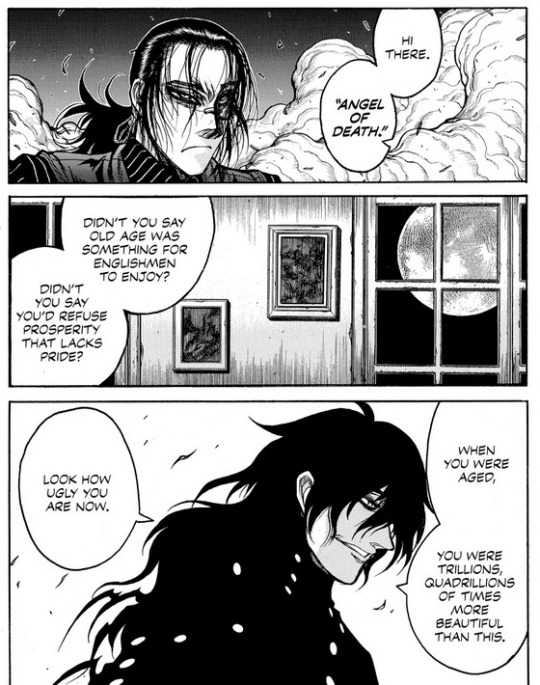
You’d think this would be leading up to some big double-team on the Hellsing group, now that the Iscariots are out of the picture, but the Captain’s only stopping Heinkel so Walter can have a clear shot at Alucard. That’s the sole reason Walter turned traitor, you see. He wants to fight Alucard and win, and for the last 55 years they’ve been on the same side.
But is that all it is? I never got to read or watch “Hellsing: The Dawn”, the prequel manga Kouta Hirano created after Hellsing. I’ve heard that it never got finished, but also an anime adaptation was released with the home video release of Hellsing Ultimate Episode VIII. All I really know about it was that there was this time where Alucard and Walter were fighting the Nazis, and the Captain showed up, and Alucard ran away because he didn’t think he could beat that dude. Presumably, he left Walter to fend for himself? But all three of them survived until 1999, so I’m not sure what the outcome of that was. I always wondered if Walter held a grudge over that. But maybe I’m reaching.
There’s also a suggestion of professional jealousy. Walter was a rockstar vampire hunter in his youth, but he’s been overshadowed by Alucard, who is--let’s face it-- a living legend. This would be doubly true in the 90′s, when Integra reawakened Alucard, and Walter having to step back even further from the spotlight. The only way for him to reclaim his former glory would be to challenge the greatest of all vampires and win. He’d go down in history as a traitor, but at least he’d be cemented as the absolute best.
Or... or, you can go with the TFS version, where Walter hints at his motives, only for Alucard to take the wind out of his sails and announce “because you wanna fuck me!” And I love that theory more than any other explanation, because it just brings everything together a lot more neatly. I guess you don’t need Walter to have had a crush on Alucard for 55 years, but it’s a lot more compelling than revenge or professional jealousy. Those things have weight, sure, but they work better as distractions, the things Walter might admit to because they hide the deeper reason that he can’t bring himself to say out loud.
And it’s not entirely rejected by the manga. Alucard remarks on how much more beautiful Walter looked in his old age, compared to this treasonous knockoff vampire look he’s sporting now. The last time he spoke this way, it was when he flirted with Queen Elizabeth II. The next time he does it, it’ll be with Sir Integra when she’s in her early 50′s.

Speaking of QE2, she’s safe and sound, because the Secret Service evacuated her to a fortified location in Dover before Millennium attacked. If things get really hairy, they’re prepared to send her to Canada, and if London can’t be secured, they’ll nuke the whole city, though the Queen is certain that Integra and Alucard will win the day. The vampires acting as Millennium agents outside of London are being contained and destroyed, so things seem to be getting under some semblance of control.
However, the Royal Order of Protestant Knights, also known as the “Round Table” is down to just three surviving members. Integra’s in London, but here we have Rob Walsh and Hugh Irons, reflecting on the death of their fellow Round Tabler, Penwood.
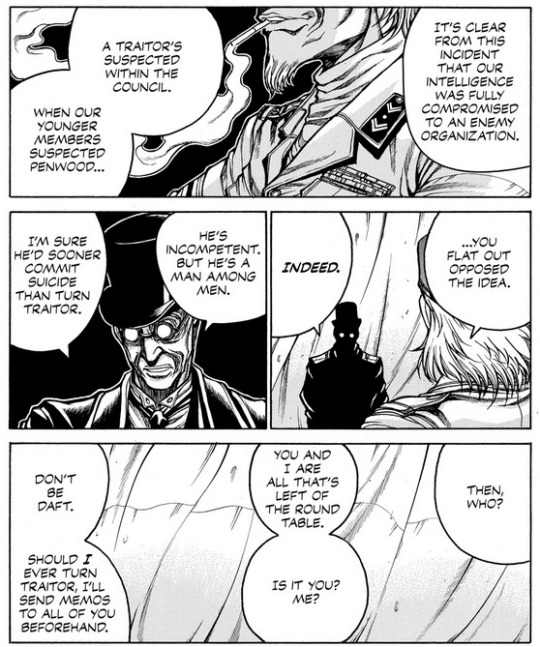
This whole scene struck me as a complete non sequitur when I first saw it in the anime. Walter’s betrayal seemed to sudden and poorly explained that it felt like the author was just winging it by this point, and now we have these two dudes struggling to provide some justification for the twist. But reading this manga in 2021, I find that it makes a lot more sense. We’ve already seen tons of Britons in rather lofty positions, all willing to sell out their principles for a chance to become a vampire. Walter is no different from any of them. It’s just more personal when he does it because we actually know the guy.
But as Walsh discusses the utter debacle of this Millennium invasion, he deduces what we’ve just learned back in London. There must have been a traitor in their ranks, because that’s the only way Millennium could have made it this far. I mean, they just flew a bunch of giant blimps full of rockets right into British airspace. That only worked because they had traitors sabotaging the U.K.’s defenses and communications, and Hellsing was especially vulnerable at the same time.
The only thing Walsh can’t figure out is who the traitor was, since it had to be someone at the Round Table, but they’re all dead now, except for Integra, Irons, and himself.
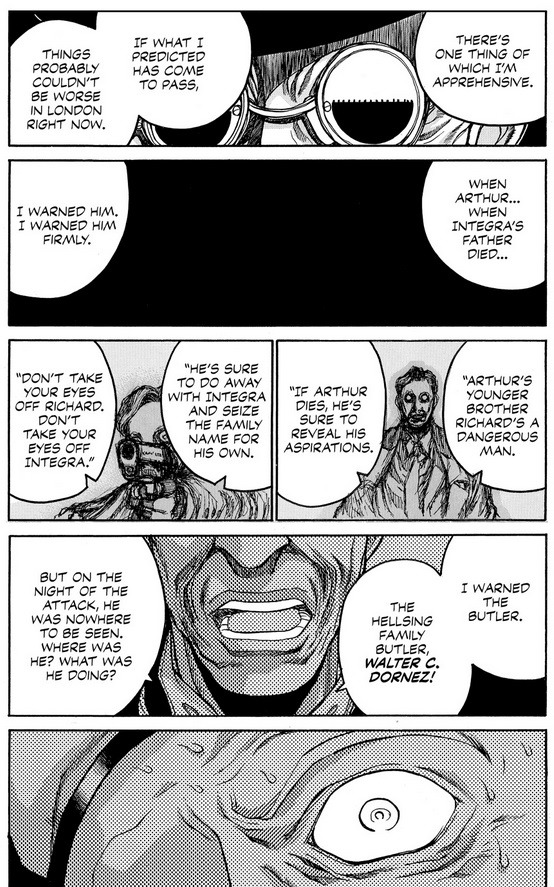
But Irons fills in the missing pieces. It doesn’t have to have been one of the Round Table’s members, but someone close to one of the members. Years ago, Irons warned Walter about Richard Hellsing. Irons knew that when Arthur died, Richard would try to make a play for the Hellsing estate. But when Irons’ fears came to pass, Walter wasn’t there. It’s like he wanted things to play out the way they did.
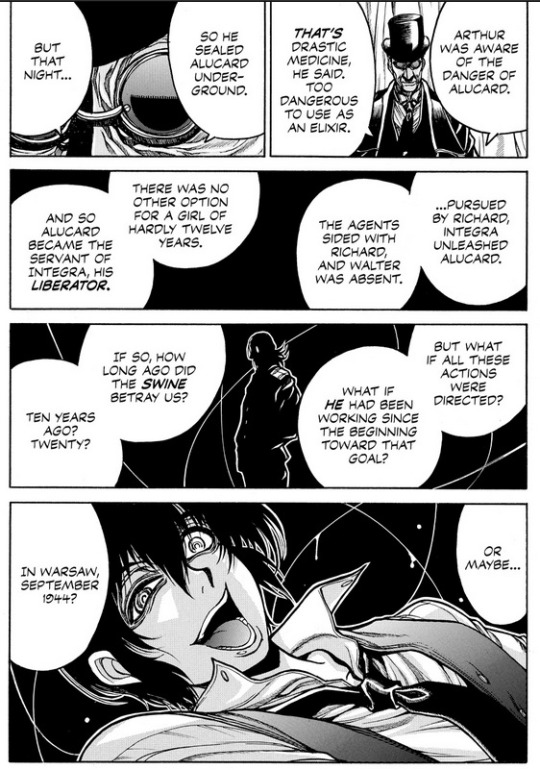
But why would Walter want events to play out that way? On her own, Integra had no choice but to unseal Alucard to defend herself, and she’s kept Alucard active ever since. And now, lo and behold, Walter reveals that he turned traitor just so he could take on Alucard. It’s like he arranged for all of this to happen years in advance. But how many years? Fifty-five, Irons wonders.
It’s never explicitly confirmed, but Irons’ reasoning makes too much sense to ignore. Earlier, the Major said that he decided back in ‘44 that Walter “Angel of Death” Dornez would have been a good “get” for his side. Now, Irons is suggesting that Walter might have agreed in the same year. So maybe Walter and the Major made a secret agreement even then. It’s possible that they might have done it later, but why not in 1944?
I mean, the whole backstory here is that Millennium is a continuation of a secret Nazi Vampire project that Walter and Alucard destroyed in 1944. Except they didn’t destroy it at all, which sure makes Walter and Al seem very bad at their jobs, unless Walter let them escape and covered it up.
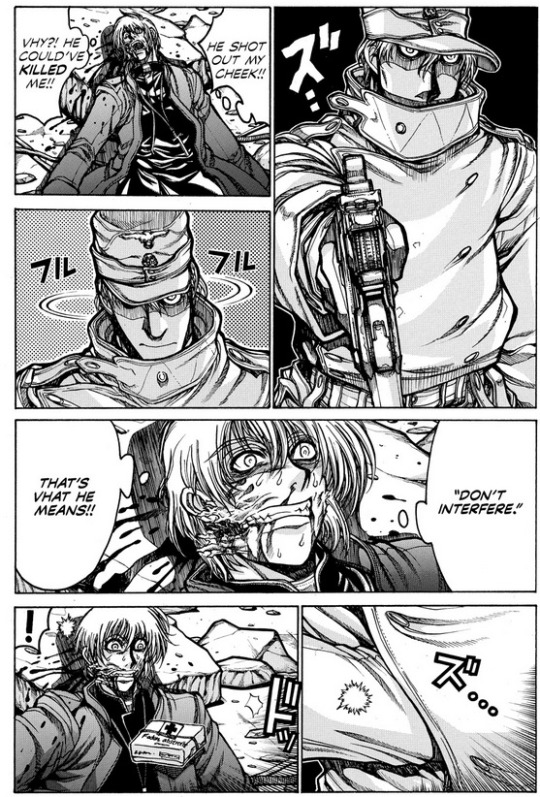
Meanwhile, the Captain tosses a first aid kit to Heinkel, kind of like he’s saying that he doesn’t want to kill Heinkel, but he can’t let her interfere either. We’ll talk about the Captain later.
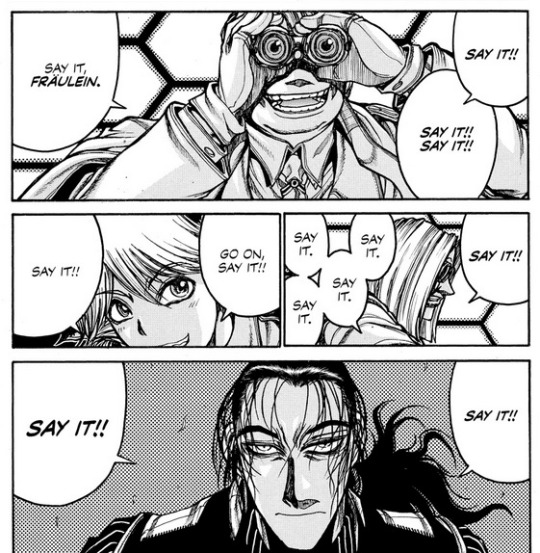
As for Alucard vs. Walter, Al wants to check with Integra before he goes through with it. He asks for orders, repeating his big speech from when he killed all those cops in Brazil. Yeah, Walter’s a traitor, but he’s been a close mentor and advisor to Integra for all these years. Does she really want Alucard to killerize his ass?

Yes, she does. If Walter stands against them, then he’s the enemy, and Integra has already ordered Alucard to destroy the enemy, no matter who (snif!) they may be. Integra doesn’t relish this command, but she refuses to compromise over sentimental feelings.
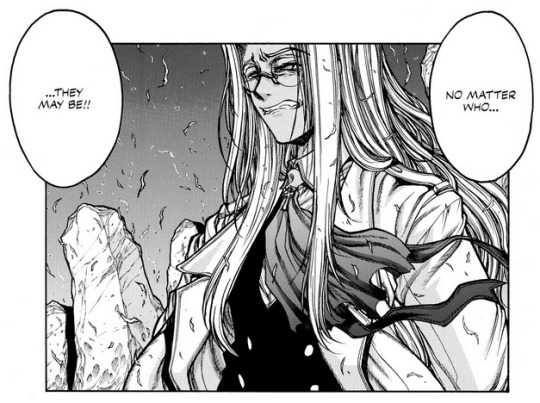
Man, fuck you, Walter.
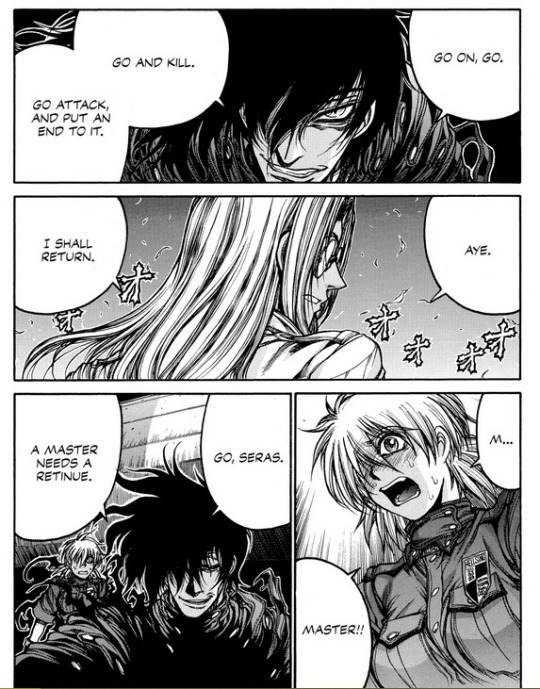
Then the Major lands his airship near the battlefield and invites Integra to come aboard and fight all of his remaining guys. Alucard orders Seras to join her while he deals with Walter. I can appreciate Seras’ concern here, because the last time she watched Alucard fight alone, he took a flaming bayonet to the face. She probably doesn’t care for Integra and Alucard splitting up like this.
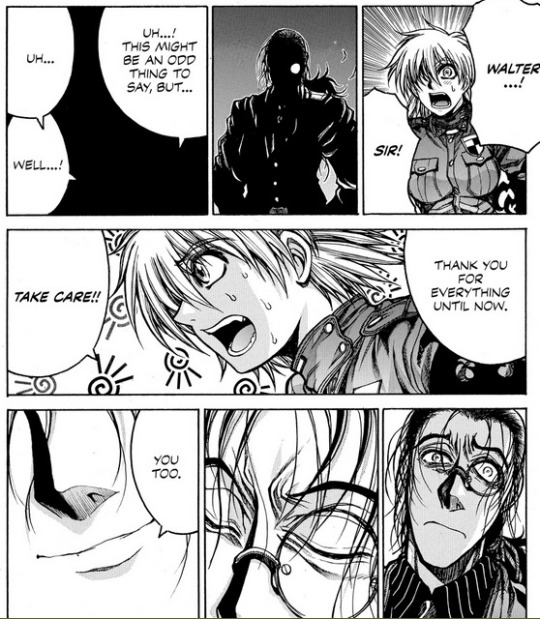
Before she goes, she thanks Walter for all of his support, which disarms Walter for just a moment. Man, fuck you, Walter. Seras is so nice and grateful and polite and cool and you just go right ahead with your 55-years-in-the-making Nazi Vampire Jilted Lover scheme. Fuck you, Walter. You don’t deserve to be in Seras’ life.

So the gals go on board the airship and Schrodinger’s there and Integra just shoots him right between the eyes without bothering to slow down. This is maybe my favorite Integra moment in this thing. I sort of wish Kouta Hirano had done a spin-off of Integra and Seras doing cool shit like this for 30 years.
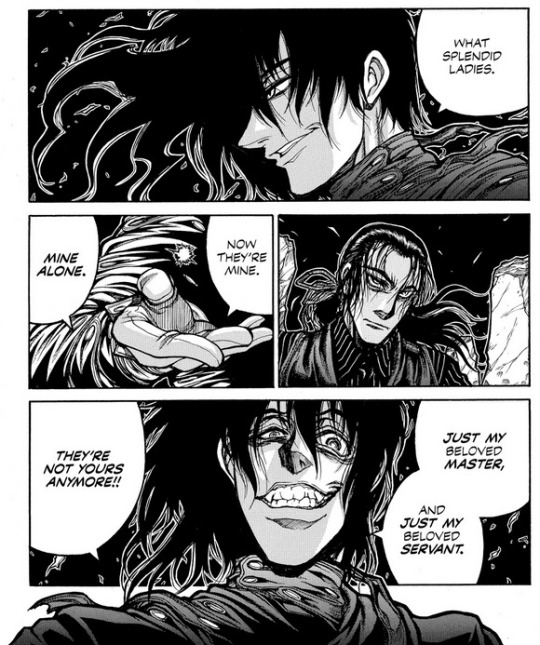
Alucard taunts Walter with the fact that he no longer gets to be a part of Inegra or Seras’ lives anymore. It sounds kind of petty, but when you think about it, it’s a pretty sick burn. Walter may have been planning this for 55 years, but he still had to live that double life, and it’s not like he can just say he was faking it the entire time.
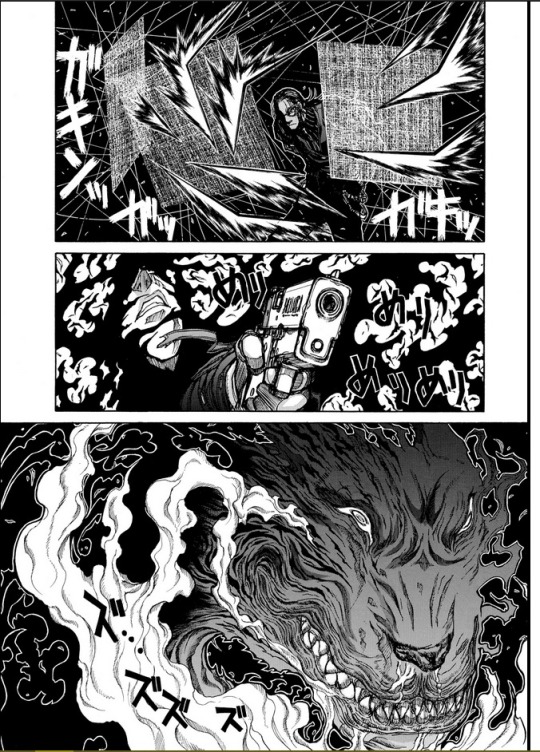
So they fight. Walter’s magic wire powers seem to be amplified, either because of his restored youth or maybe the boost offered by vampire powers, or maybe he’s always been this strong but now he no longer needs to hold back anymore. For instance, he can make mesh screens with his wires to deflect Alucard’s bullets. And when Alucard summons that dog creature he used to dispatch Luke Valentine....
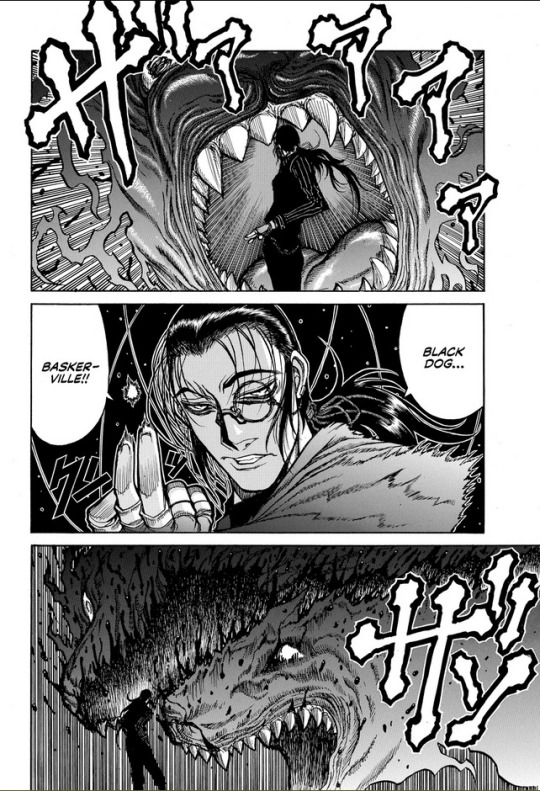
... Walter just bisects it with a flick of the wrist. You really begin to see why he was “The Angel of Death” back in his heyday.
I never understood what this dog familiar was supposed to be. Walter refers to the Hound of the Baskervilles, but as far as I know that’s just a legend confined to the Sherlock Holmes novel of the same name. But apparently that concept was based upon “black dog” folklore of the same region. There’s a whole laundry list of “black dog” apparitions in Britain alone. Black Shuck, Padfoot, Hairy Jack, Bizarro Snoopy, and so on. So I’m not sure if Hirano is saying that Alucard was the source of these legends, or if they were all based on a single creature which Alucard eventually defeated and absorbed into himself.
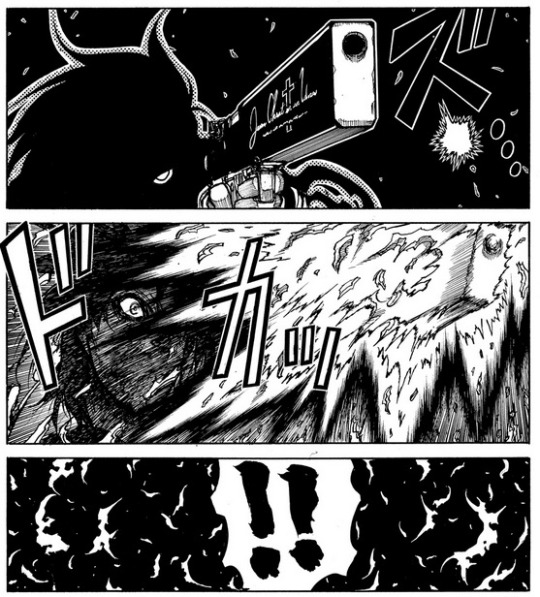
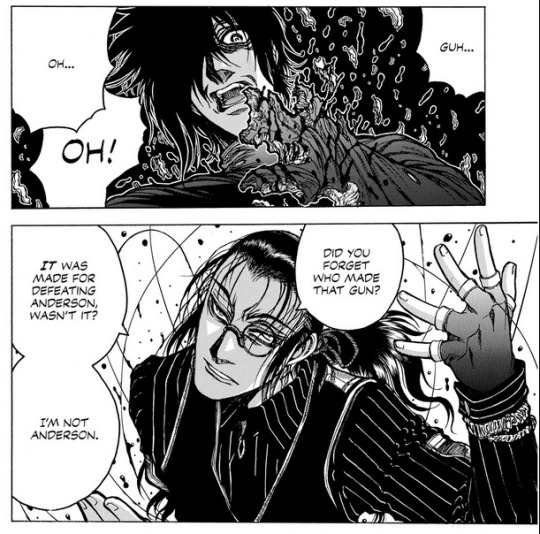
Al tries to use the Jackal to kill Walter, but that’s kind of stupid, since Walter designed the gun in the first place. In the anime, I thought Walter somehow triggered a bomb he had planted inside it, but maybe he used his wires to make this happen. It doesn’t really matter, because we already saw that the Casull was useless against Walter’s defenses, and not because it had smaller ammunition.
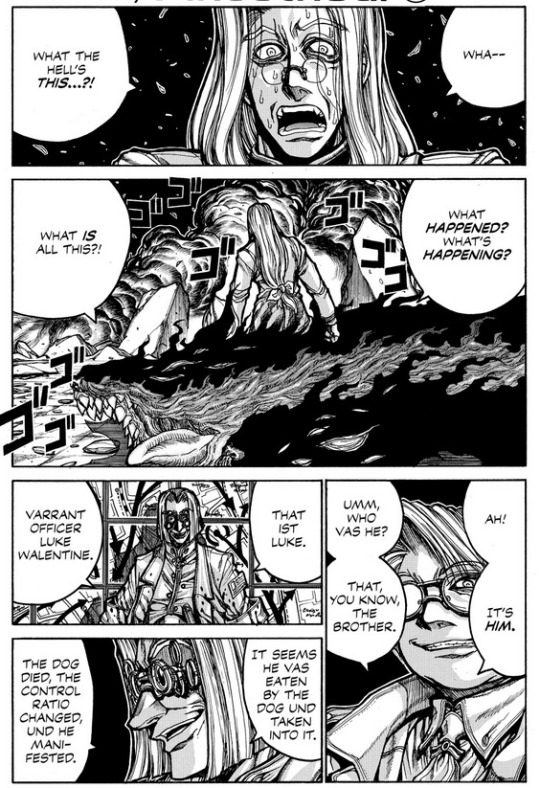
Then Luke Valentine emerges from the black dog’s body. This part never made any sense to me, but I loved how the Major recognized him, but barely. “Oh yeah, it’s that guy from Volume 2! The guy with the brother.”
The doctor suggests that when the dog was killed, this allowed Luke to reassert himself from inside the dog. Something about a “control ratio”, whatever that is. Like, he was absorbed into the dog’s mass, but now that the dog is no longer conscious, he can think for himself again. Notably, only half of Luke actually makes it out . It’s like he’s half-Luke, half dead dog monster.

But before he can do anything else, Walter puts his wires into Luke and starts controlling him like a puppet, mostly so he can use the dog half to attack Alucard.

Alucard seems more impressed than threatened. Keep in mind, Walter was doing pretty damn well against him early on. You’ll notice Alucard’s missing his right arm along with one of his guns. This is better than Anderson managed to do. So why does Walter even need this Luke-dog puppet thing in the first place?
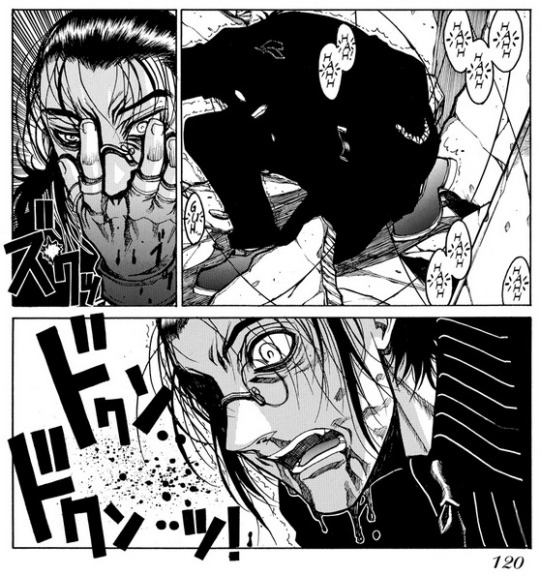
Well, it’s because Walter’s body is giving out on him. Earlier, when the Doctor was performing the procedure to turn Walter into a vampire, he spoke about how rushed the operation was. I mean, he had to finish the whole thing in one night, after all. And Walter’s a lot more powerful than Dandyman, whom the Doctor considered his finest artificial vampire work. So maybe Walter’s just too powerful for this, and he can’t sustain this form. The Luke-dog-thing is just to keep Alucard busy while he coughs up blood.
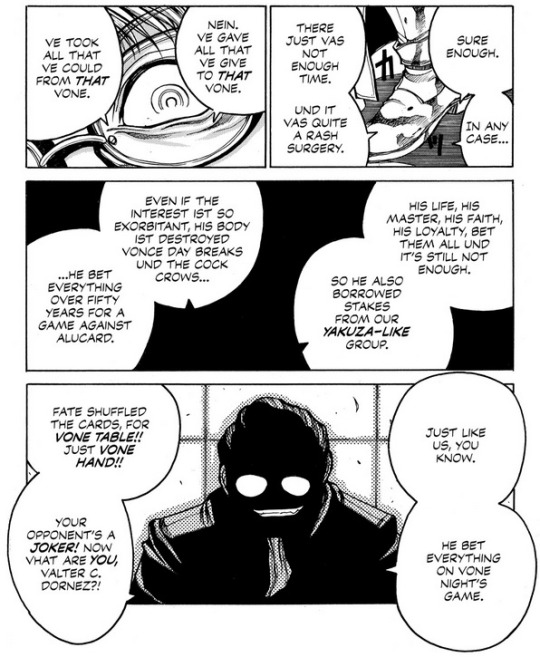
The Major sees this development, and likens Walter to a high stakes gambler who’s mortgaged everything for a single hand at a high stakes table. Walter’s risked everything just to tangle with Alucard, and it still isn’t enough.

Alucard does manage to finish off the dog-Luke thing, and this sets him up for Walter’s next attack, and then he goes to finish him off, so things seem to be going Walter’s way...
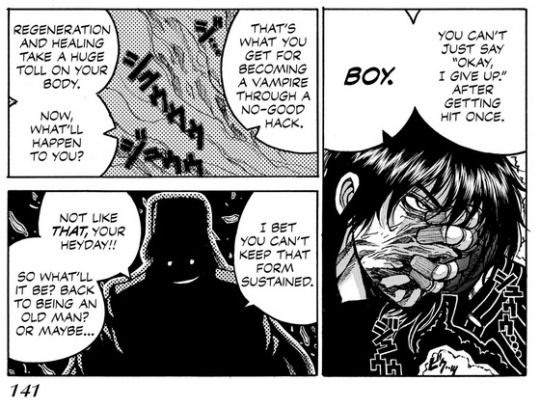
But Alucard used a decoy, disguising Luke’s severed torso as his own, all so he could sucker-punch Walter in the face. As it turns out, Walter’s physical breakdown is making him younger, which amuses Al to no end.
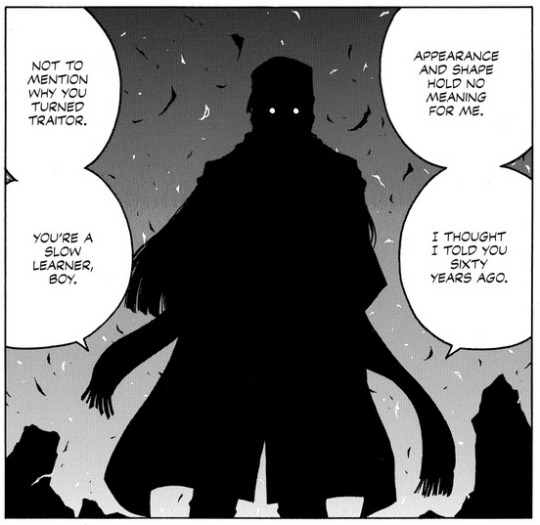
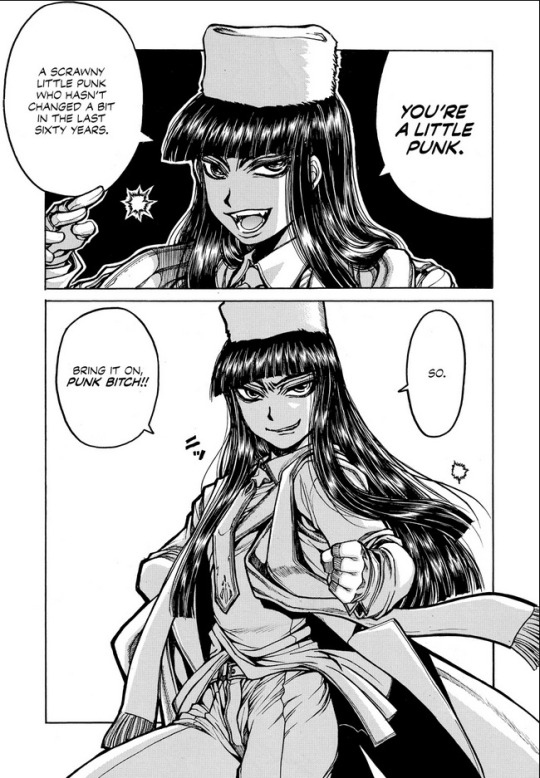
So Alucard follow suits and assumes the form he once used when they fought the Nazis in 1944. Yeah, say hello to “Girlycard”. I’m not sure why Alucard looked like a 14-year-old girl during World War II. I’ve heard this form described as a Japanese 14-year-old girl, and I can’t dispute it, but it also makes Girlycard seem even more random somehow.
I mean, I guess the idea here was for Walter and Alucard to be able to move inconspicuously through enemy territory. No one would suspect a couple of kids until it was too late. I’m imagining a similar scenario to the ones presented in “Cross Fire”. Heinkel and Yumi would play innocent bystanders, then whip out their guns and swords and go ham on the bad guys. Knowing Hirano’s style, maybe Girlycard and Young Walter operated the same way.
And this further supports the Walter-had-an-unrequited-crush-on-Alucard theory. He might have understood that Girlycard was a disguise. On an intellectual level he might have known, but maybe he still carried a torch, and told himself that there was some way that they could be together. Was he just in love with this disguise, or does he love the real thing? Alucard says that he told Walter the truth decades ago, and claims that this is the reason Walter turned traitor, so yeah, it sure feels like Walter couldn’t handle Alucard’s true nature, one way or another.
I mean, let’s assume that this isn’t just about Alucard not being a cute girl. Maybe Walter fell in love with Alucard in all his forms, whatever that means for his sexuality. The bigger issue is that Alucard’s a vampire, and he’s just fundamentally different from Walter, and maybe that was the problem all along. It’s interesting to think about, but the point here would be that there was some kind of problem, and Walter couldn’t let it go.
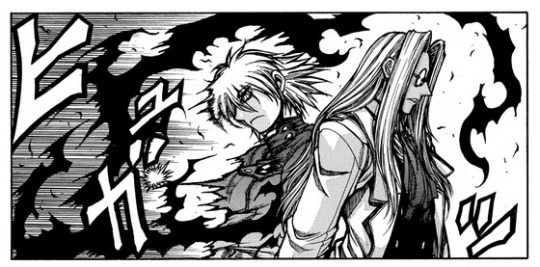
Meanwhile, Seras and Integra are busy looking like total BMFs. Just HBIC’s. What’s better than this? Two gals bein’ pals.
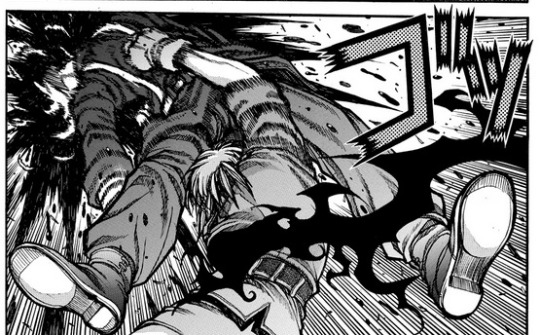
Hell yeah!

Bad ass!

The vampires on board this airship are happy to meet their doom, and Integra recalls what her father once told her about how vampires want to die on their own terms. Seras doesn’t get it, because if they want to die so badly, they could have just died in the war they were already in fifty-odd years ago.

So the Major gets on the PA system and explains to her that they want more than just a glorious death. They want bigger, better, more perfect battlefield, so as to make their deaths as meaningful as possible. That’s why I don’t understand that airship captain from a while back. Everyone else in Millennium seemed to understand that they weren’t necessarily fighting to win. Britain is prepared to nuke London if they have to, so it’s hard to imagine anyone in Millennium surviving past today, even if they won.
Anyway, as the Major explains all of this, the Captain appears before the gals. It looks like he’s here to stop them, or is he?
#2021hellsingliveblog#hellsing#alucard#seras victoria#walter c dornez#alexander anderson#heinkel wolfe#yumiko takagi#the major#the captain#warrant officer schrodinger#sir hugh irons#lt general rob walsh#luke valentine#really? luke valentine?
23 notes
·
View notes
Text
Halloween 2021 - Day 5 - The Invisible Ray (1936)

Doesn’t that just sound like a bad magician? “Ladies and gentlemen, introducing...The Invisible Ray!”
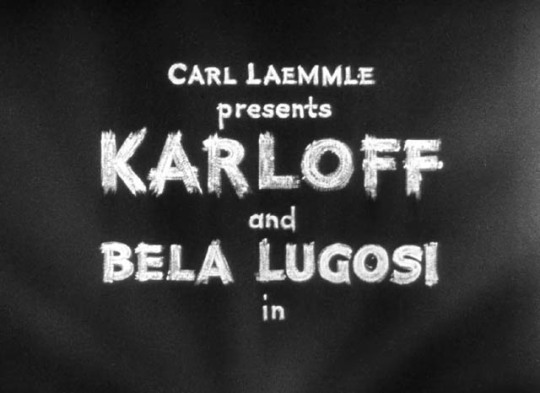
Ah, this takes me back. Back in year 0 of this horror marathon business, before this blog was a thing, it was kinda heavily skewed towards the ‘classic’ period; Dracula, Frankenstein, The Mummy..all that Universal 1930’s type stuff. Amongst that first run were a pair of films starring both KARLOFF and Bela Lugosi; The Black Cat and The Raven. I remember them both being quite good, both having this sort of rivalry between their two characters. The Black Cat moreso with a young couple caught in the middle of a heated feud between KARLOFF and Lugosi’s characters. Whereas The Raven has KARLOFF as more of a de-facto good guy as he plays a reluctant henchman to Lugosi’s character. Not that that level of power translated off screen, with Lugosi’s star beginning to fade but I remember reading something about KARLOFF insisting on some parity in pay between the two in one of their movies when the studio tried to lowball Lugosi so good on you, KARLOFF.
Neither have much to do with the Edgar Allan Poe stories they take their names from, outside of Lugosi’s character in The Raven having an obsession with Poe and adapting various means of torture from Poe stories. There have been plenty of Poe adaptations throughout the years but the other big uptick in them was in the 1960’s with a series of films directed by Roger Corman, often starring Vincent Price but with other big names sprinkled in like KARLOFF, Peter Lorre and Lon Chaney Jr. Plus a relatively early Jack Nicholson appearance in The Raven, which was shot at the same time as The Terror. That bloody bird!
So, yeah, it’s good to see one of these KARLOFF/Lugosi films again. Apparently there are eight films that featured both of them so I’ll be halfway there now on them. This also has Carl Laemmle Jr’s name attached, albeit in a minor way as he’s listed as ‘presenting’ the movie. I’m not sure if that ever means anything. It’s like when Tarantino ‘presents’ something, did he have any actual input on the film or was he just shining a light on something he personally liked because he has so much power and influence?

The movie’s foreword is an early indicator of the more science-fiction leaning nature of the movie which catches you off guard a little with the people involved and the timeframe we’re working in. Feels like the 50’s was more when the whole sci-fi thing took off. Also, since when was science a verb?
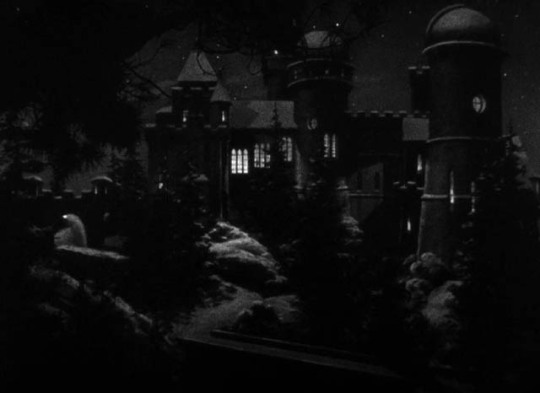
Certainly has the feel of that classic ‘old, dark house’ horror thing early on as we start with the Rukh household awaiting the arrival of some of Dr Janos Rukh’s (KARLOFF) peers who are to bear witness to his new discovery.
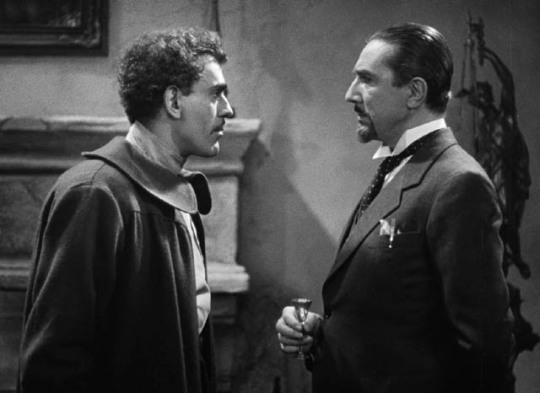
KARLOFF has clearly been eating his crusts to get curls like that, normally he’s a slicked back kind of guy. And it’s kinda weird seeing both of them with facial hair. Oddly though this is one of the rare times that Lugosi plays a good guy, this is a clear violation of the parallel universe protocol:
Normal universe – clean shaven – good guy
Parallel universe – goatee – evil

This early version of Dr. Doom is a bit naff. Are you making a great scientific discovery here or doing a spot of welding?

Apparently Dr Rukh’s invention is a telescope that is able to see into the deepest reaches of space, but can also pick up on vibrations left by the events that have taken place and he can then project that as a moving image that shows an asteroid crashing to Earth millions of years ago that can help him pinpoint the crash site and allow him to discover new elements inside the asteroid...wait, what?! Is this like that time on CSI when they solved a murder by getting sound out of something someone made in pottery class because the grooves could be played like a vinyl?

We then pivot sharply into the great plains of Africa where our team have set off in search of what will become known as ‘Radium X’. Oh yes, I think that’s on the periodic table next to Hardtoobtainium. And I’m specifically trying to avoid animal cruelty by not watching Cannibal Holocaust, don’t come around here with your dead leopards and talk of how many rhinos you’ve shot. I must say I’m a little wary of this sudden introduction of all these natives carrying spears and wearing bone necklaces, I just don’t feel like I can trust a movie made in the 1930’s to be sensitive on it’s portrayal of other cultures.
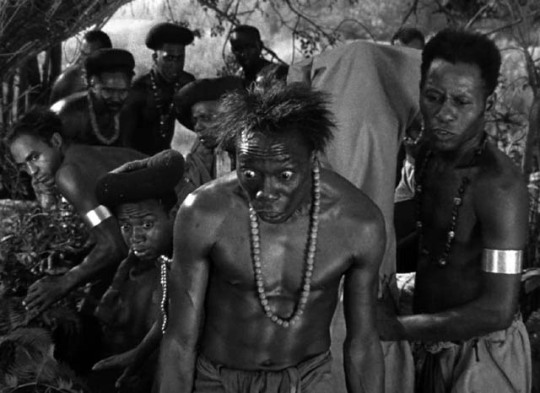
Thought it does present us with the best actor in this picture, look at those bug eyes! He’s like Africa’s answer to Marty Feldman.

And that’s just his reaction to a piece of scanning equipment going off, him and his mates are definitely going to be worried when this white devil makes a demonstration of his new found Radium X and it’s ability to melt pure stone. Looks like a portajohn backing up...
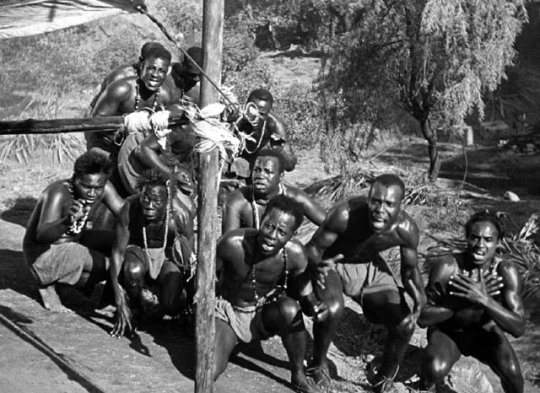
He then promptly turns his cosmic ray gun on all the locals when they tell him they want to go home. Sure, you can leave, you’re not going to get very far though. Dude, there’s like 12 of you and he’s given some of you rifles. Just jump him when he’s asleep.
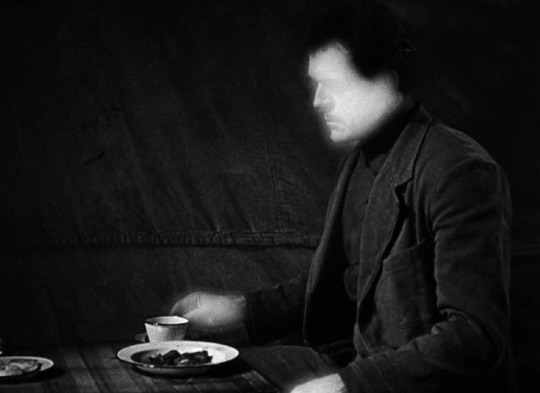
Dr. Rukh finds that evening that he’s suddenly turned an interesting shade of neon yellow and can be seen by anyone in a three mile radius so either this Radium X is highly poisonous or Rukh has been running in opposition to Vladimir Putin. This poisoning leaves him so irradiated that merely touching another living thing is enough to kill it. Dr. Benet (Lugosi) is able to make a serum for him but can never truly cure him, he must regularly take this serum or otherwise he will revert to this killing machine type state.
But, in his eagerness to not spread this poison to his wife, and his general upholding of the man code to never air ones medical problems, he generally acts a bit surly and tells her to piss off which see views as him not loving her anymore so he promptly shacks up with the young explorer type who came with them to Africa. Worse yet, Benet and crew have taken a sample of Radium X to show at a scientific conference in Paris. Between losing his missus and thinking that other people are taking all the credit for his work, Rukh is just slightly annoyed.

It’s not all bad though, he is able to use this new element to cure his mother’s blindness. I like how his first reaction upon learning that Radium X has irrecoverably changed his life, leaving him one missed injection away from imminent death, is to shoot it directly into his mother’s face.
“Patients won’t like being shot in the face.”
“They’ll like what I tell them to like.”

Whilst sulking outside of the church that his ex is getting re-married in, he spots a series of statues of saintly figures and imagines them representing each of the 6 people on the African expedition, vowing to destroy each of them until only he is left. Marvelous invention this Radium X, it can melt statues and cure blindness. Do you have to put special filters on that ray gun of yours depending on the situation? That’s a malpractice suit waiting to happen if you mix those up.
Dr. Benet is a little suspicious when one of their party dies suddenly for no explainable reason so takes a few ultraviolet photos of the victims eyes in order to study. And wouldn’t you know what he finds?
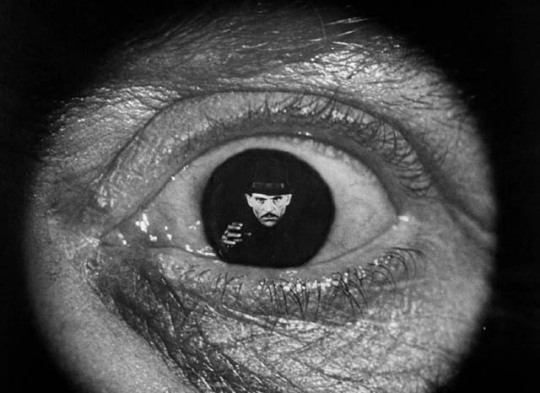
Bullshit! Nevermind the ultraviolet camera, this is more like the dues ex machine camera. I know this is science fiction and all but what is this, 1936 or 2036? Or maybe they’re just able to make the most detailed contact lenses known to man.

Eventually, when Rukh finds himself unable bring himself to kill his former love, he is confronted by his mother who smashes the serum and condemns him to death as, going unchecked, the Radium X within him will destroy his body. Sensing the end coming, Dr. Rukh dives out of the nearest window and promptly erupts bursts into flames, now left as little but a pile of ash on a damp Paris street. It’s a shame really, dozens of people spontaneously combust every year, it’s just not widely reported.”
This one was okay, definitely a different vibe compared to other Universal stuff at the time with all the science fiction and Africa based stuff but it does still travel down that ‘descent into madness’ thing that they often fall back on and it’s always fun to see KARLOFF and Lugosi, especially when they’re together. But, if we’re strictly talking about the KARLOFF/Lugosi pairing, I’m definitely leaning towards one of their other outings like Black Cat, Raven or Son of Frankenstein. There’s just something not right about Lugosi playing some normal, if he’s not being unhinged then you’re not really getting what you came here for.
2 notes
·
View notes
Note
what're your thoughts on castlevania (the netflix show, not the game, ive never played the game) what do you like, what don't you like? make it as long as you want. i don't care if i have to scroll for 5 minutes. go feral (personally trevor is extremely hot and i would like to date sypha. i'm not really into alucard's whole sickly victorian child aesthetic, yknow?)
oh god this is way too long, but you did say to make it as long as i want, and i have a lot of thoughts that i need to inflict on the world
i played two castlevania games, both from the nintendo gameboy era, so please don’t get mad at me, gamers
details below the cut, but since i’ll be talking about season three, i need to preface this with content warnings for mentions of: graphic violence, rape and sexual violence, racism, and the holocaust
before i get into it, i usually don’t go for alucard-type characters either, but knowing that he was redesigned to be bishounen sexy specifically because the boring, middle aged man look he originally had in the games wasn’t appealing makes me enjoy him. and he’s fun with trevor and sypha
do like:
the voice acting
it’s all good. i can’t think of any characters whose voices were awkward or fit poorly. they don't make sypha’s va use the standard flat affect or false high voice women tend to be assigned, trevor sounds suitably worn out but not monotone, and alucard sounds exhausted but in a sexy way
and the spanish dub is killer, arguably superior
the animation & design
it isn’t full-on artsy, but it’s definitely got a distinctive style that’s easy to look at. the color use and effects are gorgeous. it’s a story set in the medieval era, and the mixture of desaturated and oversaturated elements works so well with that
dracula’s castle and the belmont bunker aren't revolutionary in design, but they didn't need to be. they're suitably creepy and empty, and i enjoyed them
the monsters were unique enough to have obvious different types, and the scene where a monster commits blasphemy in a church by accusing a priest of committing blasphemy was good writing
lisa
she shows up to a stranger’s spooky home and scolds him for being rude. she really looked an ancient vampire in the face, told him he had no manners, then had a kid with him. what a phenomenal woman. 11/10, no notes
“start with me, and i’ll start with you.” you know what? i’d fall in love, too
dracula
this ancient, unfriendly vampire let a human woman walk into his home and tell him he’s got no manners. and that made him fall in love with her. just like that. lisa walked in and handed him his ass, and dracula thought “oh i love her”. and when she was killed (more on this in the bad section), he raised literal hell to destroy the world for doing it
speaking of lisa being killed, it fucks me up that it happened because she convinced him to leave the castle and experience the world. he left her alone to see what she loved so much, only to come back and find that the people he’d come to like- the people lisa had loved so much it drove her to help in a way that got her killed- had burned her at the stake. i love a good tragedy, and that’s good tragedy
the way he weeps when he has to fight alucard?? during a showdown in their home?? the “i must already be dead” moment in alucard’s childhood bedroom??? when he speaks to lisa about killing their boy, her greatest gift to him??? poetic cinema.
the trio’s dynamic
three bisexuals with two total brain cells and only alucard bothers using them. incredible
i went so hard for this ot3. it's right there and so good
sypha
she initially seems to be assigned the role of the adult™️ ie she's the only woman and gets stuck being responsible, but surprise! she’s just as annoying and dumb as alucard and trevor. she dropped a castle she didn’t understand on the ground and didn’t think too hard about it. then she argued about breaking it. i love her
if we don’t get an ot3, then she needs to have a dumb gf
alucard
he's got a stupidly low neckline and lower pants. they really leaned into ayami kojima’s redesign, as they should have. his little curl annoys me, though. why the fuck does he have a random section of hair that’s like three inches long when the rest is shoulder length or longer? love that he really looks like lisa
if you say he's canonically bisexual and polyamorous, no he isn't. yes he is. no he isn't :)
trevor
disgusting. a nasty man whose appearance mirrors his state of mind. he's 50 mental illnesses in a dirty jacket and his coping mechanism is… alcohol? maybe? he’s a mess, and i dig it
him trying his trick of kneeing alucard in the balls during their fight? and finding out it doesn't work? (which…… why doesn't it……?) juvenile but suitable
hector
his love of animals makes him my favorite. normally, i won’t touch anything with this much animal death, but i’m willing to set that aside because hector loves them so much. he’s so sweet and kind, and he loves his monster pets
yes he sided with dracula and has some really fucked up ideas about what constitutes humane treatment of people, and yet i love him. 11/10, but i have a lot of notes
isaac
i support him, including his murdering and his decision to support dracula. dracula throwing him out of the castle to save him was so cruel in that it was an attempt at kindness from a man who hated the whole world, but it was against isaac’s wishes
his time with the captain was great
idk enough about islam to know if he's portrayed correctly and haven’t seen any complaints, but given the show’s track record……… i wouldn’t be surprised if it’s not great
the forging
very cool. fresh and interesting! hector creating pet friends is cute and heartbreaking. love isaac for his dedication to reducing, reusing, and recycling
season 2’s big battle with all those vampires
the new version of “bloody tears” is phenomenal
this goes back to the animation, but listen……. it's so good. i loved the smoke vampire, and alucard’s fluid wolf transformations. his flying sword looked really good, and incorporating them together? super good to watch. and trevor’s whip?
the type and level of violence are suitable for what it is. it would be weird for a gritty show like this to be bloodless, but i don't think it would work if it were bloody to the extent of a slasher. it's also more clean violence, if that makes sense. you don’t linger just to look at gore; you see it because stabbing someone spills blood. the games weren't about extended, gritty scenes of realistic murder, so the show sticking with quick, slice and dice type fights fit with what i remembered of them
please watch this fight if you don’t remember it or haven’t seen it (part 1, part 2)
trevor’s whips
trevor’s weapons don’t follow the physics of normal whips, and they shouldn't. they’re heavily stylized and clearly a fantasy weapon, but they still have rules that they (mostly) have to obey. his morning star-whip hybrid in particular is so good
it’s easy to follow, too. a lot of times, speedy weapons disappear, which is an understandable effect but one i find boring because there’s nothing for me to do. i’m just sitting on my ass with nothing to do
trevor’s whips don’t disappear. they’re fast, but you can always see them. and they have weight! you can see them slow down and gain speed. i don’t need physics to be real; i want movement to be pleasing, and that’s exactly what i get with the whips
don’t like:
fridging lisa
she could have been kidnapped (possibly make dracula think she was dead bc people want to lure out her scary demon husband, idk), then s2 could have ended with her and dracula reuniting as he died. she and alucard go on a trip together to attempt to make amends for the pain dracula wrought in lisa’s name. orrrr she dies a tragic death with him and we’re left to hope that they find each other in the afterlife. do vampires get to go to the afterlife? can alucard reintegrate? can he be happy with his new friends? or will he go back to his crypt and sleep again? will he ever be rediscovered? if so, what will he do? deep questions. i would prefer to cogitate on these instead of experiencing the shitshow that is s3
season 3
they should have ended it with dracula’s death. the quality of storytelling goes down immediately. just plummets. i’m sure there were problems in the first two seasons, but this one is so bad, i genuinely can’t remember
but i may as well get specific, so here we go:
abandoning alucard
trevor and sypha leave their friend alone in his childhood home where he just killed his father. where they helped him kill his father who, as i’ve said too many times, raised literal hell to get revenge for people burning alucard’s mother to death
yt they don’t talk about alucard. they don’t make any plans to touch base ever again. trevor’s entire family got killed. sypha’s culture, from which she’s now estranged, is family-centric. if ever two people should give a shit about alucard and know why alucard shouldn’t be left on his own, it's them
so what the hell is going on?
trevor and sypha’s relationship
look. it could be good. it would be better with alucard but they could be together and it could work fine
but this……….
trevor hates what they're doing. he hates traveling around and fighting. he's clearly tired and deeply depressed
sypha not only doesn't care enough to address it (did they forget the first two seasons?? sypha is annoying partly because she doesn't stop poking people) she might not even notice? yes, she's having fun, but trevor is basically dead on his feet in front of her
racism
hector, sumi, and taka all got done dirty
sumi and taka
i hate the way they died. i hate that i’m certain that the plot won’t bring japan back into the narrative (or if it does, i don’t trust it not to be shitty). i hate the fact that by killing them off, i’m not going to get any more of them. they were interesting!!
speaking of the japanese vampire: the biphobia, arguably, given what happens with alucard
the addition of sexual violence
i don’t need or want lenore. if all she’d done was manipulate hector, i could have lived with that. she’s a villain, so she does bad things. that’s the point. but what she did was a massive escalation. we hadn’t had any sexual violence, and then the last few episodes gave us
tumblr feminists who love her for how she treated hector need to be quarantined until their brain worms have been cured
everything that happens to hector
what was this shit? why did i open my netflix app and tap castlevania and find them making this man walk around naked in the cold to torture him? and starving him? he got manipulated, degraded, chained up, collared like an animal, and raped. and why? to show us how bad lenore is? that the other vampires are bad because they let her do it? i didn’t sign up for this
the holocaust reference
the imagery at the end of s3 when it’s revealed that the judge has been killing people he’s decided are undeserving to live and collecting their shoes in that barn was chillingly close to images of shoes taken from victims of the holocaust. there's no reason to invoke the holocaust here. it’s unnecessary and in bad taste
#asks#anonymous#long post#anti-castlevania netflix#i guess#cw rape#cw holocaust mention#cw racism#cw holocaust#all of these are tags i didn't anticipate using on my stupid sideblog#i'll probably find a bunch of typos in like 12 hours rip me#but i feel bad for taking so long
10 notes
·
View notes
Photo
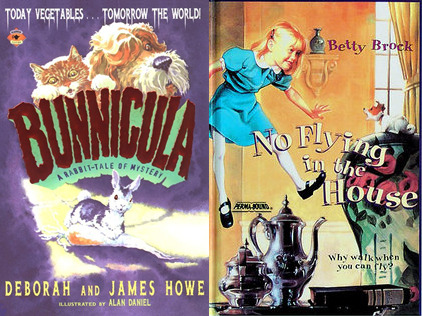
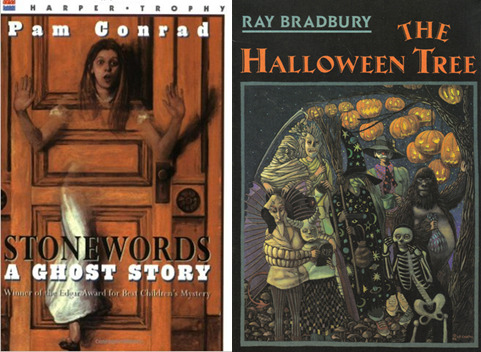




Because I like making lists and sharing info about stuff I like, I decided to share a small group of a few of my favorite books; specifically, ones that are SPOOKY somehow (some are about magic, some are about more sci-fi stuff, but all still a bit spooky). These are all books that I own, so this isn’t like a “top 50 best spooky books ever” kind of thing, just what I have on my shelf in no particular order. Also, these are all children and young adult books, I’ll save the grown-up horror books for a different list (these books vary in levels of spooky, from mild to hard-core, but are still generally safe for most people to read)
If you like to read and have some time to hunt these down, you might enjoy them. If you are into spooky stories, these might inspire you and provide ref for writing ideas-
BUNNICULA by Deborah and James Howe
NO FLYING IN THE HOUSE by Betty Brock
STONEWORDS A GHOST STORY by Pam Conrad
THE HALLOWEEN TREE by Ray Bradbury
MALICE by Chris Wooding (also, the sequel HAVOC)
CORALINE by Neil Gaiman
HECK: WHERE THE BAD KIDS GO by Dale E Basye (seven books total in the series)
HOW TO DRIVE YOUR FAMILY CRAZY… ON HALLOWEEN by Dean Marney (originally titled “The Jack-O-Lantern that Ate my Brother)
SKULLDUGGERY PLEASANT by Derek Landy (nine books total)
THE HAUNTING OF DEREK STONE by Tony Abbot (four books total)
SCORPION SHARDS by Neal Shusterman (part of the star chronicle series)
WELL WITCHED by Frances Hardinge
(some descriptions of the books under the cut)
BUNNICULA by Deborah and James Howe
Told from the perspective of Harold the dog, we are introduced to a new family pet; a cute little bunny found in a box at the theater (that was showing Dracula). After the important task of naming the little fluff-ball Bunnicula is over, the family is content to have their new pet. Though, he is a little odd… he sleeps all day, and they never see him eat. The family cat Chester, Harold’s dear friend, is suspicious that this bunny isn’t all that he seems. Clues of what Bunnicula truly is begin to pile up, literally, when other members of the family discover vegetables that have been completely drained. Chester is convinced that when it comes to Bunnicula today it might only be vegtables, but tomorrow it could be the world! Harold isn’t quite so sure the “vampire rabbit” is dangerous, and Bunnicula might be the one who needs help.
NO FLYING IN THE HOUSE by Betty Brock
A mysterious child has come to live with a very rich woman, in her very big house, and brings with her a very tiny dog; Gloria, a talking dog and Annabel’s guardian, is looking after her. Annabel doesn’t think Gloria is strange. To her, this is a normal life, and she loves everything in the house… except the strange, tiny cat that appeared and started telling Annabel secrets. Annabel learns she is actually very strange, because she isn’t an ordinary little girl, she is half-fairy and can even fly! This isn’t all good news though. Annabel has to choose between different parts of who she is, and whatever she decides can change her life forever
STONEWORDS A GHOST STORY by Pam Conrad
Zoe’s mother brought her to live with her grandparents when she was very little, and on her first night at her new house, she could feel another little hand holding hers even though nobody else could see her “imaginary friend”. Zoe Louise and Zoe spend every day together, they play, they talk, they grow up together… well, Zoe grows, but Zoe Louise stays the same. Sometimes, Zoe Louise disappears up the door of the back stairs, and Zoe is afraid to follow her. As Zoe gets older, she finally takes a trip into her friend’s world, and realizes her friend needs her help, but she needed it a long time ago. When Zoe visits a cemetery and sees her name, her friend’s name, on a grave stone, she finally has the courage to go through the door and into the past, hopefully to change a terrible tragedy
THE HALLOWEEN TREE by Ray Bradbury
On Halloween night a group a friends meet to go trick-or-treating… but someone is missing. Pip, the best of them all, is supposed to be in the hospital for appendicitis, but his friends are sure they saw him run toward a creepy house, so they follow him. This is where they meet Mr. Moundshroud, and where they see a tree full of pumpkins on every branch, carved faces that range from looking almost human to ghoulish, candles glowing within them. Mr Moundshroud tells the kids that Pip has stolen a pumpkin from this tree, and has fled not just to another place but another time. In order to save their friend from a mysterious fate, the kids go on a journey to different eras around the world, where they learn meanings behind different traditions about life and death
MALICE by Chris Wooding (also, the sequel HAVOC)
Part illustration and part language, this book blends comics with the novel, as well as fantasy and reality. You see, there is a mysterious comic book, hard to find, and even if you get one the pages go blank after time passes… it depicts a strange and horrifying world called MALICE, full of monsters, and also children who have been transported there from the real world. An urban legend says if you gather the right ingredients and say the right words, Tall Jake will come and take you away. It turns out to be very real, and soon two kids begin a search and rescue mission to find their friend. The thing is, not everybody survives being the star of the comic, and you might only make it into one issue
CORALINE by Neil Gaiman
Coraline is an explorer; she has explored the garden, she has explored her room, she has explored the hallways, she has explored everywhere in her new house… except whatever room is behind the strange locked door. Once Coraline finds the key, she goes down a dark corridor and comes out in… the same room. The same, but different. This is the same house, but it is another house. She also has an Other Mother, with black button eyes, who promises that Coraline will find this world much more interesting. She does, but Coraline still wants to go back to her real home with her real parents. The Other Mother doesn’t like that; she wants Coraline to stay with her forever and always, she wants Coraline to love her, and all Coraline has to do is let her sew the buttons… to save her life, the ghosts of children who came before her, and her parents, Coraline stands up to the Other Mother with some unexpected help from her crazy neighbors and a Cat that doesn’t need a name
HECK: WHERE THE BAD KIDS GO by Dale E Basye (seven books total in the series)
Bad kids get punished, even if they aren’t alive anymore. Milton and Marlo Fauster find this out the hard way. Down in Heck, there are many different types of “punishment”; like Wise Acres for the sassy kids, or Snivel for the whiny kids. There are seven circles of Heck, so you’ll fit in somewhere. Full of demons and puns, Heck isn’t just a place for bad kids, it is a very bad place for kids. Some of the punishments don’t really seem fair, and some kids never learn a lesson. Could there be a way for Milton and Marlow to go up, to heaven or at least back to the land of the living? Or will they just keep going down
HOW TO DRIVE YOUR FAMILY CRAZY… ON HALLOWEEN by Dean Marney (originally titled “The Jack-O-Lantern that Ate my Brother)
Lizzie is annoyed that her parents never listen to her, she’s annoyed that she’s getting teased about her name (getting called “Lizzie Borden”), but most of all she is annoyed by her little brother. She wishes she could just enjoy Halloween all by herself, but her parents are making her take him around the neighborhood. Lizzie tries to look out for him, especially when a woman dressed as witch offers him some shifty candy. Lizzie told him not to touch it, but do little brothers listen? Now Lizzie is being put to the test by the witch, who is in fact, an actual witch. She has to rescue her little brother from a haunted house, full of everything Lizzie is afraid of
SKULLDUGGERY PLEASANT by Derek Landy (nine books total)
Stephanie’s uncle left her a mansion full of his possessions after he passed away, and she also seems to have inherited a few problems; strangers demanding she give them the “key” and attacking her. She is saved by a skeleton, held together by magic, with the ability to conjure fire balls. If that doesn’t work against his enemies, he does also have a gun. Stephanie becomes part of this secret world full of sorcerers after meeting the magical detective Skullduggery Pleasant, deciding to help him solve the mystery of her uncle’s death and locating the key. She learns a lot about magic, the power of names, meets many other magic-users, and uncovers a sinister plot that could destroy the world
THE HAUNTING OF DEREK STONE by Tony Abbot (four books total)
14-year-old Derek thought he was the only survivor in his family after the train accident… but eventually, his older brother turns up. His brother doesn’t seem quite right though. He doesn’t remember much about his life, but does talk a lot about things he does remember. To Derek, it sounds like the life of somebody else. Eventually, Derek figures out that the person in his brother is someone who died many years ago, in another train crash in the same place. The dead are coming back, and some of them are very dangerous. Derek’s new life dealing with the dead takes him all over New Orleans, through the bayou, and to some places he’d rather not go
SCORPION SHARDS by Neal Shusterman (part of the star chronicle series)
Six young people who have never met have something in common; they aren’t normal. They have odd abilities, strange powers, and unfortunate afflictions that cause them pain, fear, and suffering. Slowly, they begin to meet each other, and figure out what is happening to them… and what they really are. It isn’t just their bodies that are hurting, it is their souls; they are all pieces of a star that went supernova long ago, and within their large star-sized souls are parasites that are killing them. They have to learn to work together, overcome their fears, battle their demons, and find the courage to save themselves
WELL WITCHED by Frances Hardinge
At some point, almost everybody has tossed a coin into a well and made a wish. Nobody really expects the wish to come true. You just have to find the right well… or the wrong well. To pay for the bus, three kids stole some coins from an old wishing well, and become responsible for the wishes connected to the coins. If they resist their duty, they are visited by the spirit of the well; she might be a witch, or she might be an old forgotten goddess. Either way, she torments the kids until they do what she wants. You see, she has a hard time understanding some of the complicated things people wish for in the modern world, but the kids do. She even gives them special abilities to complete the tasks. It is almost like doing good deeds… but once certain things are set in motion, they don’t stop. There is an ebb and flow to wish-granting, give and take, and coins are only part of the price
#books#illustration#book covers#writing#stories#ref#spooky#bunnicula#no flying in the house#stonewords#the halloween tree#malice#coraline#heck where the bad kids go#how to drive your family crazy on halloween#skulduggery pleasant#the haunting of derek stone#scorpion shards#well witched#magic#monsters#halloween#fairies#sci fi
25 notes
·
View notes
Text
We people of Earth are experiencing a renaissance in horror on TV like we’ve never enjoyed before, as traditional gatekeepers are dispersed in the wild hunt for content, any content that is compelling or innovative or just plain outré enough to collect people at watercoolers, where presumably advertisers can drop a net on the whole pack and harvest their disposable incomes and/or pineal juices. There’s Scream Queens, Scream, American Horror Story, Ash Vs. Evil Dead, Stranger Things, Bates Motel, and so many more jostling for your eyeballs, and they are all worthy of your eyeballs. The surprisingly gory Supernatural is in its 80th season, I think, and The Walking Dead has proven itself stronger than even zombie fatigue. And for every Penny Dreadful or Hannibal that is cut down, a Twin Peaks or X-Files will rise. But everyone in my house is sick, and have been in various configurations for the last month and a half, so I can’t tell you about any of those new shiny things at the moment. Sick babies are hell on your Netflix queue. And while David Cronenberg and Anthony Burgess’ epidemiologic horror is also top of mind these days, I find myself ultimately retreating to the comfort food of old favorites. In this case, the genteel rictus smile of Boris Karloff’s Thriller.
Stephen King had high praise for Thriller in 1981’s Danse Macabre*, and you’ve got to respect Stephen King’s opinion in these matters. Deference to King aside, since it wasn’t widely syndicated like The Twilight Zone, The Outer Limits, Alfred Hitchcock’s anthology shows, and a slew of others, and I fall in the Gen X cohort that missed the first go-around, I never actually clapped eyes on the show until Netflix picked it up a few years ago. There’s only two seasons, but these are 1960s seasons, so the hour-long format delivers a full 50 minutes of content, not the 37-42 minutes we get today, with a total of 67 episodes, so it certainly doesn’t feel like a short-lived series. I think a show would have to be on for almost a decade in Britain to ding 67 eps.
In a lot of ways, Thriller is just like its horror anthology contemporaries and successors: weird standalone teleplays – usually horror, but sometimes a crime or mystery story — starring many faces who, if not already famous and beloved, would certainly become so later on: Ida Lupino (who also directed a boatload of these and scripted one), John Carradine, Leslie Neilsen, Ursula Andress, William Shatner, Harry Townes, Elizabeth Montgomery, Rip Torn, Mary Tyler Moore, and on and on and on. The stories tended to be horror siphoned from a very EC Comics vein, where bad people succeeded in bad things, only to be visited with hells of their own making. The most upfront difference was its host, a man once simply billed by his forbidding last name in Universal’s horror heyday, Boris Karloff, who also starred in a handful of the stories as a glorious bonus.
Boris was a big value add, no question, not only bringing the heft of his horror credentials, but investing every host segment with superbly ghoulish glee. Each episode, after an appropriately shocking cold open, Boris would step into the scene or the camera would pan to reveal him, much in the manner of Rod Serling’s introductions in The Twilight Zone, but instead of Serling’s moralistic omniscience, Boris was conversational and warm, and the bloodier the subject matter, the more delighted he seemed. It’s a neat trick, possibly unparalleled, to be at once so kindly and so sinister. I could watch nothing but a loop of his host sequences for hours. And Boris really worked for it. When he warned, “And those were no ordinary pigeons. They were pigeons from hell!” you knew he meant it. Before the lights went down for the story proper to begin, he would also introduce the cast, reminding you of the unreality of it all briefly before returning to his convivial threats. I love these sequences, especially when the cast physically walks into the picture with Boris, looking haunted or malign, and I love that, at least initially, Boris referred to them as “Mr. Rip Torn. Miss Patricia Barry,” etc. It’s exquisitely mannered. The tagline was, “As sure as my name is Boris Karloff, this one is a Thriller!” And he was pretty true to his word.**
There were a few clunkers, though there always are, and even the success of the better episodes may be a matter of taste, particularly several decades after some of the punchlines and the story outlines have been retold so often they’re blunted with quaintess. But the source material was as top notch as The Twilight Zone at its height, harvesting work from August Derleth, Robert E. Howard, Richard Matheson, and particularly Robert Bloch, who wrote seven episodes. And hell, Ray Milland directed an episode about Jack the Ripper. There was a ton of talent going into these shows, and if it had had a better timeslot, maybe it would have survived to become the institution The Twilight Zone (deservedly) is. Thriller did at least spawn a comic series, Boris Karloff Tales of Mystery, which survived the show and Karloff both into the 1980s.
My favorite Thriller episodes all turn on that EC Comics flavor horror. You could easily swap out Boris for the Crypt Keeper as far as that goes, but I do prefer Karloff’s puns. Here, in no particular order, are my five top Thriller episodes for the adventurous viewer. There’s a DVD collection, plus it’s currently showing on the Decades cable channel. You may find many episodes on YouTube.
William Shatner did two Thriller episodes, and I have a hard time picking a favorite. Part of this is simply because Shatner’s really good in both. People make fun, but he’s a damn fine actor, and his black-and-white work could be a lot more restrained than we expect from Captain Kirk or Denny Crane. In “The Hungry Glass,” based on a Robert Bloch story, Shatner is one half of a young married couple who have just bought a house . They were sold the house by a realtor friend, who you may also recognize as Russell “The Professor” Johnson, and it has a spooky reputation that has kept the Century 21 sign out front for a generation. When the Shatners take possession of the house, they’re there for approximately a minute before the realtor’s wife screams that she saw a figure outside the window, and it’s not Torgo because the window overlooks a scenic sheer drop. There are nervous chuckles and rationalizations, but it doesn’t take very long at all for Shatner and his wife to start seeing fleeting figures in reflective surfaces. And then the wife finds an attic full of mirrors.
The second Shatner episode is called “The Grim Reaper,” another Bloch adaptation, and it stars a cursed painting that really looks like sweet heavy metal van art. Here, Shatner is the nephew of a different castaway, Natalie Schafer, who plays an eccentric, exuberant, and very alcoholic mystery writer. She recently acquired the cursed painting because she’s the kind of person who would, and her caring nephew has come to warn her off of it. As he explains, when the scythe of the depicted grim reaper drips blood, someone will soon die. And wouldn’t you know it? He touches the painting to demonstrate and comes away with bloody fingertips. That same night, his aunt discovers her husband is trying to snuggle her assistant. It’s a story that’s equal parts Clue and the Roddy McDowall vignette in the Night Gallery pilot, and it’s perfect.
My third Thriller pick is called “The Hollow Watcher.” The Hollow Watcher is a scarecrow, and I love demon scarecrow stories. It is also a story of southern white rural poor, which always interests me since, well, I was/will always be, and their treatment always grabs my interest, but it’s fair here.*** It starts with Denver Pyle as a meaner version of Briscoe Darling, attacking his son Hugo’s mail-order Irish bride. As father and son fight it out, the bride sneaks up and whacks Daddy dead. Since the son was pretty well knocked out by his father, she’s able to convince him that he beat his father so profoundly that his father ran away, forsaking his land. Hugo, in hillbilly man-child mode, expresses anxiety that “The Hollow Watcher,” a scarecrow up on the hill/avenging monster will visit judgment on him for raising a hand to his elder. In the meantime, a man claiming to be her brother arrives on the scene, his wife recently dead. Hugo is called away, and brother and sister are revealed to be man and wife grifters with a very Crimson Peak approach to building a nest egg. Hugo might be gone, but the Hollow Watcher still overlooks the property, and as Boris reminds us, “The beliefs of simple country folk can create forces that can certainly surprise you.”
Next, I choose “The Terror in Teakwood,” a story about a hatred between two concert pianists so white-hot, it survives death. Hazel Court plays the wife of the still living pianist Vladimir Vicek (Guy Rolfe), disturbed that since the death of his rival Karnovich, he’s been acting, well, a little weird, and she keeps finding him covered in blood. She thinks that someone is trying to kill him. So she goes to her ex Jerry (Charles Aidman) and asks him to come work as her husband’s manager, while secretly trying to get to the bottom of the blood-covered husband biz. Imagine how worried she’d be if she knew what her husband did at his rival’s grave in the cold open.
Lastly, I recommend “The Incredible Doktor Markesan,” based on an August Derleth story, starring Boris Karloff as the titular doktor with Dick York and Carolyn Kearney as his nephew and nephew’s wife, driven to the door of his Old Dark House in penniless desperation. Markesan, creepier even than his house, agrees to let the poor couple stay, but insists they never leave their room after dark, and just to be sure, he locks them in. Markesan, sweetie, if it didn’t work for Dracula, it’s not going to work for you.
Those are my favorites, but even as I make the list, I want to recommend “The Purple Room” for the Psycho exteriors and Rip Torn almost unrecognizably young, “Mr. George” for its darkly comedic tale of a specter foiling three wicked people’s attempts to kill their young ward, Patricia Barry’s Jekyll and Hyde performance in August Derleth’s “A Wig For Miss Devore,” the weird voodoo weirdness of the Robert E. Howard story “Pigeons From Hell,” and on and on. This show has so many goodies. Even the crime thriller episodes have their good points, like…Robert Lansing. “Late Date” is a pretty good one of those, based on a Cornell Woolrich story. And while there’s a lot of exciting new stuff out there that deserves your attention, just because something’s of a certain vintage, that doesn’t mean you should give it up for dead.
[manic laughter, discordant organ music begins]
* Among Stephen King’s very astute judgments in Danse Macabre, I have, with time and home ownership, come to appreciate his verdict on The Amityville Horror as being mostly horrifying when you think how much money that poor family hemorrhaged.
** Of course, he never legally changed his name from William Henry Pratt, so if a show wasn’t a thriller, I suppose the joke would be on us.
***I will note here that the setting is rural North Carolina, and everyone pronounces the word “hollow” with a long o sound at the end. That has a very spooky ring and is certainly evocative of a man made of straw, but since it refers to a place, i.e. the hollow the scarecrow is watching over, it really should be pronounced “holler,” especially by country folk. I assume no North Carolinians were consulted in the making of this episode.
~~~
Angela does wonder about the alternate timeline where Bela Lugosi hosted an anthology show.
For No Mere Mortal Can Resist We people of Earth are experiencing a renaissance in horror on TV like we’ve never enjoyed before, as traditional gatekeepers are dispersed in the wild hunt for content, any content that is compelling or innovative or just plain outré enough to collect people at watercoolers, where presumably advertisers can drop a net on the whole pack and harvest their disposable incomes and/or pineal juices.
#anthology#August Derleth#Boris Karloff#Boris Karloff Tales of Mystery#Boris Karloff&039;s Thriller#Crypt Keeper#Danse Macabre#Denver Pyle#Dick York#EC Comics#Elizabeth Montgomery#Harry Townes#Hazel Court#Ida Lupino#John Carradine#Leslie Nielsen#Mary Tyler Moore#Natalie Schafer#Ray Milland#Richard Matheson#Rip Torn#Robert Bloch#Robert E. Howard#Rod Serling#Stephen King#The Outer Limits#The Twilight Zone#Universal Studios#William Shatner
1 note
·
View note